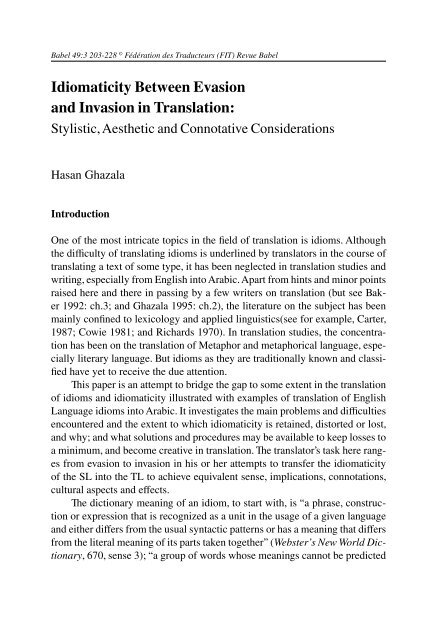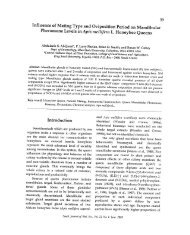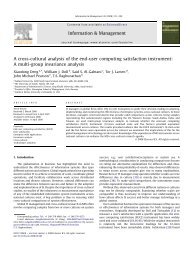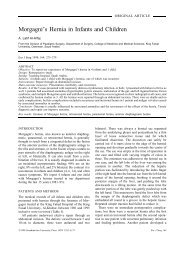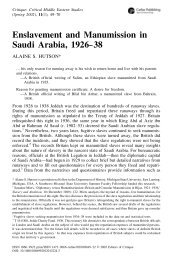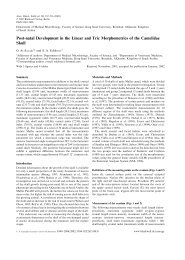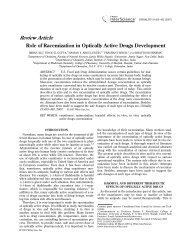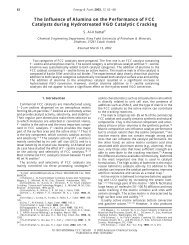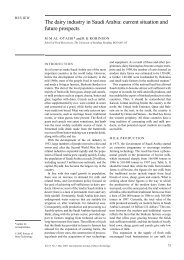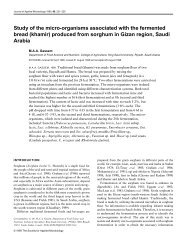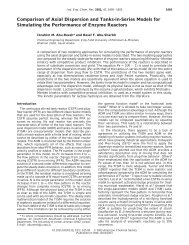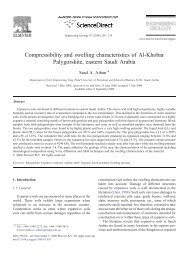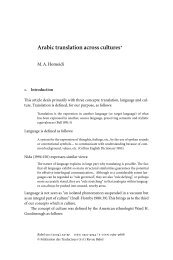Idiomaticity Between Evasion and Invasion in Translation: Stylistic ...
Idiomaticity Between Evasion and Invasion in Translation: Stylistic ...
Idiomaticity Between Evasion and Invasion in Translation: Stylistic ...
Create successful ePaper yourself
Turn your PDF publications into a flip-book with our unique Google optimized e-Paper software.
Babel 49:3 203-228 © Fédération des Traducteurs (FIT) Revue Babel<br />
<strong>Idiomaticity</strong> <strong>Between</strong> <strong>Evasion</strong><br />
<strong>and</strong> <strong>Invasion</strong> <strong>in</strong> <strong>Translation</strong>:<br />
<strong>Stylistic</strong>, Aesthetic <strong>and</strong> Connotative Considerations<br />
Hasan Ghazala<br />
Introduction<br />
One of the most <strong>in</strong>tricate topics <strong>in</strong> the field of translation is idioms. Although<br />
the difficulty of translat<strong>in</strong>g idioms is underl<strong>in</strong>ed by translators <strong>in</strong> the course of<br />
translat<strong>in</strong>g a text of some type, it has been neglected <strong>in</strong> translation studies <strong>and</strong><br />
writ<strong>in</strong>g, especially from English <strong>in</strong>to Arabic. Apart from h<strong>in</strong>ts <strong>and</strong> m<strong>in</strong>or po<strong>in</strong>ts<br />
raised here <strong>and</strong> there <strong>in</strong> pass<strong>in</strong>g by a few writers on translation (but see Baker<br />
1992: ch.3; <strong>and</strong> Ghazala 1995: ch.2), the literature on the subject has been<br />
ma<strong>in</strong>ly conf<strong>in</strong>ed to lexicology <strong>and</strong> applied l<strong>in</strong>guistics(see for example, Carter,<br />
1987; Cowie 1981; <strong>and</strong> Richards 1970). In translation studies, the concentration<br />
has been on the translation of Metaphor <strong>and</strong> metaphorical language, especially<br />
literary language. But idioms as they are traditionally known <strong>and</strong> classified<br />
have yet to receive the due attention.<br />
This paper is an attempt to bridge the gap to some extent <strong>in</strong> the translation<br />
of idioms <strong>and</strong> idiomaticity illustrated with examples of translation of English<br />
Language idioms <strong>in</strong>to Arabic. It <strong>in</strong>vestigates the ma<strong>in</strong> problems <strong>and</strong> difficulties<br />
encountered <strong>and</strong> the extent to which idiomaticity is reta<strong>in</strong>ed, distorted or lost,<br />
<strong>and</strong> why; <strong>and</strong> what solutions <strong>and</strong> procedures may be available to keep losses to<br />
a m<strong>in</strong>imum, <strong>and</strong> become creative <strong>in</strong> translation. The translator’s task here ranges<br />
from evasion to <strong>in</strong>vasion <strong>in</strong> his or her attempts to transfer the idiomaticity<br />
of the SL <strong>in</strong>to the TL to achieve equivalent sense, implications, connotations,<br />
cultural aspects <strong>and</strong> effects.<br />
The dictionary mean<strong>in</strong>g of an idiom, to start with, is “a phrase, construction<br />
or expression that is recognized as a unit <strong>in</strong> the usage of a given language<br />
<strong>and</strong> either differs from the usual syntactic patterns or has a mean<strong>in</strong>g that differs<br />
from the literal mean<strong>in</strong>g of its parts taken together” (Webster’s New World Dictionary,<br />
670, sense 3); “a group of words whose mean<strong>in</strong>gs cannot be predicted
204 Hasan Ghazala<br />
from the mean<strong>in</strong>gs of the constituent words” (Coll<strong>in</strong>s English Dictionary, 760,<br />
sense1); “... metaphorical rather than literal ... also more or less <strong>in</strong>variable <strong>and</strong><br />
fixed <strong>in</strong> form or order ...” (Longman Dictionary of English Idioms, viii); “...<br />
the sense of the whole cannot be arrived at from a prior underst<strong>and</strong><strong>in</strong>g of the<br />
parts” (Oxford Dictionary of Current Idiomatic English, vol. 2, x); <strong>and</strong> to “...<br />
underst<strong>and</strong> every <strong>in</strong>dividual word <strong>in</strong> a text <strong>and</strong> still fail to grasp what the text<br />
is all about” (A Dictionary of American Idioms, iv). Five po<strong>in</strong>ts are common<br />
among these def<strong>in</strong>itions:<br />
1. Idioms are all <strong>in</strong> all metaphorical <strong>and</strong> cannot be understood directly.<br />
2. They should not be taken literally; <strong>in</strong> the sense that their mean<strong>in</strong>gs are not<br />
the outcome of the <strong>in</strong>dividual mean<strong>in</strong>gs of their constituent words taken<br />
collectively.<br />
3. Their syntactic form is usually fixed <strong>and</strong> cannot be changed or described as<br />
ungrammatical. Moreover, no word can be added, deleted or replaced(see<br />
also Baker 1992: 63).<br />
4. Their mean<strong>in</strong>gs are also <strong>in</strong>variable.<br />
5. (Not <strong>in</strong>cluded <strong>in</strong> those def<strong>in</strong>itions) They are ma<strong>in</strong>ly cultural <strong>and</strong> <strong>in</strong>formal<br />
(see also Longman Dictionary of English Idioms, op. cit.).<br />
Thus, idioms are special, metaphorical, fixed phrases whose mean<strong>in</strong>gs <strong>and</strong><br />
forms are not negotiable. Their most special <strong>and</strong> essential component is idiomaticity,<br />
namely, their metaphorical aspect. Hence its crucial importance <strong>in</strong><br />
translation, to the extent that the success of a translation of an idiom st<strong>and</strong>s <strong>and</strong><br />
falls with the degree to which idiomaticity is reta<strong>in</strong>ed or distorted.<br />
Types of Idioms<br />
Idioms are of different types. They are also classified differently by writers<br />
<strong>and</strong> st<strong>and</strong>ard reference books. In the Oxford Dictionary of Current Idiomatic<br />
English, for example, the types of idioms are based on a certa<strong>in</strong> underst<strong>and</strong><strong>in</strong>g<br />
of idiomaticity: “A view of idiomaticity which does full justice to the rich<br />
diversity of word comb<strong>in</strong>ations <strong>in</strong> English must recognize that the mean<strong>in</strong>g of<br />
a comb<strong>in</strong>ation may be related to those of its components <strong>in</strong> a variety of ways,<br />
<strong>and</strong> must take account also of the possibility of <strong>in</strong>ternal variation, or substitution<br />
of part for part.” Accord<strong>in</strong>g to this bilateral view, idioms are categorized<br />
<strong>in</strong>to four ma<strong>in</strong> types: (a) Pure idioms: full, perfect idioms that are established<br />
through constant re-use, then undergo figurative extension <strong>and</strong> f<strong>in</strong>ally petrify
<strong>Idiomaticity</strong> <strong>Between</strong> <strong>Evasion</strong> <strong>and</strong> <strong>Invasion</strong> <strong>in</strong> <strong>Translation</strong> 205<br />
(aptly used of various types of mean<strong>in</strong>g-development) or congeal (no longer<br />
undergo change / become fixed <strong>and</strong> well-established <strong>in</strong> language): e.g. ‘kick the<br />
bucket’. (b) Figurative idioms: The idioms of this category hardly accept variation<br />
<strong>and</strong> pronoun substitution. They are purely figurative idioms <strong>and</strong> their literal<br />
senses do not st<strong>and</strong> side by side with their figurative ones <strong>in</strong> normal, everyday<br />
use of language. In this sense, this type is not dissimilar to the previous one:<br />
e.g. ‘burn one’s boat’. (c) Restricted collocations: These are also categorized as<br />
‘semi-idioms’. They are usually two word comb<strong>in</strong>ations, <strong>in</strong> which one has a figurative<br />
sense, while the other has a literal <strong>and</strong> familiar sense: e.g. ‘jog one’s<br />
memory’ (‘jog’ is figurative, whereas ‘memory’ is not). (d) Open collocations:<br />
These are more specific, normal <strong>and</strong> flexible comb<strong>in</strong>ations of words (Adj.-N,<br />
V-N; N-N, etc. See Newmark 1988, 212; Ghazala 1993, 1995 <strong>and</strong> 2001; Cowie<br />
1981, Carter 1987, Ch.3; Baker 1992, 47-9, Morton Benson et al. 1986; Hill<br />
et al. 1997; <strong>and</strong> others) rather than fixed idioms of <strong>in</strong>variable form <strong>and</strong> sense:<br />
e.g. ‘fill the s<strong>in</strong>k’.<br />
Another clearer, more specified, extensive, but looser categorization of idioms<br />
is <strong>in</strong>troduced by Longman’s Dictionary of English Idioms(op.cit.). Twelve<br />
types are dist<strong>in</strong>guished:<br />
(a) Traditional idioms: are the well-known, most popular idioms, that are almost<br />
full sentences, only a subject to be provided: e.g. ‘spill the beans’.<br />
(b) Idioms <strong>in</strong> which actions st<strong>and</strong> for emotions or feel<strong>in</strong>gs: Cultural idioms<br />
of actions <strong>in</strong> appearance, but emotions or feel<strong>in</strong>gs by cultural implication;<br />
e.g. ‘throw up one’s arms / h<strong>and</strong>s’ (culturally, the action here is a sign of annoyance,<br />
not of happ<strong>in</strong>ess).<br />
(c) Pairs of words: idioms <strong>in</strong> which two words are jo<strong>in</strong>ed by <strong>and</strong> / or, many of<br />
which cannot be reversed: e.g. ‘cats <strong>and</strong> dogs’; ‘spick <strong>and</strong> span’, ‘hammer<br />
<strong>and</strong> tongs’, etc.<br />
(d) Allusions: words or phrases of special cultural significance <strong>and</strong> reference:<br />
e.g. ‘Westm<strong>in</strong>ster’ (the British Parliament <strong>and</strong> Government); ‘catch 22’.<br />
(e) Say<strong>in</strong>gs: <strong>in</strong>formal popular say<strong>in</strong>gs <strong>and</strong> metaphorical proverbs <strong>in</strong> complete<br />
sentences: e.g. ‘There’s always (a) next time’; ‘A roll<strong>in</strong>g stone gathers no<br />
moss’.<br />
(f) Typical conversational phrases: fixed conversational phrases whose<br />
mean<strong>in</strong>gs are not literal: ‘How do you do?’; ‘Now you’re talk<strong>in</strong>g!’.<br />
(g) Similes: these are popular <strong>and</strong> cultural phrases with ‘as ... as’ structure, or<br />
the use of like: e.g. ‘as quick as a flash’; ‘work like a horse’.
206 Hasan Ghazala<br />
(h) Archaisms: old phrases that are not <strong>in</strong> frequent use now: e.g. ‘to <strong>and</strong> fro’;<br />
‘kith <strong>and</strong> k<strong>in</strong>’.<br />
(i) Jargon: phrases or words conf<strong>in</strong>ed to special <strong>and</strong> technical use: e.g. ‘paraphernalia’<br />
(i.e. procedure).<br />
(j) Foreign phrases: French or other foreign idiomatic phrases that are <strong>in</strong> popular<br />
use: e.g. the French phrase ‘bête noire’ (black beast), used to describe<br />
a bad person.<br />
(k) Common phrases <strong>and</strong> terms: phrases that are common <strong>in</strong> use but do not<br />
present a metaphorical problem: e.g. ‘on strike’; ‘fish <strong>and</strong> chips’; etc.<br />
(l) Phrasal verbs: Comb<strong>in</strong>ations of verbs <strong>and</strong> one or two adverbial particles<br />
or prepositions that cannot be understood literally: e.g. ‘look up’; ‘read<br />
through’; ‘watch out’; etc.<br />
Carter (1987: 60), on the other h<strong>and</strong>, labels different categories of idioms under<br />
types of fixed expressions as follows:<br />
(a) Idioms:<br />
1. irreversible b<strong>in</strong>omials / compound idioms: e.g. ‘huff <strong>and</strong> puff’; ‘spick<br />
<strong>and</strong> span’; etc.<br />
2. full idioms: e.g. ‘fit the bill’; ‘smell a rat’; ‘to be <strong>in</strong> the doghouse’; etc.<br />
3. semi-idioms: e.g. ‘glassy stare’; ‘fat salary’; ‘dead drunk’; etc.<br />
(b) Proverbs: e.g. ‘to add <strong>in</strong>sult to <strong>in</strong>jury’; ‘a watched pot never boils’; etc.<br />
(c) Stock phrases: e.g. ‘a vicious circle’; ‘a recipe for disaster’; etc.<br />
(d) Catchphrases: ‘is it cold up there?’; ‘the name of the game’; ‘get lost’; etc.<br />
(e) Allusions / quotations: e.g. ‘we are not amused’; etc.<br />
(f) Idiomatic similes: e.g. ‘as ... as’ constructions.<br />
(g) Discoursal expressions:<br />
1. social formulae / clichés: e.g. ‘how do you do’; ‘long time’; etc.<br />
2. connectives; structur<strong>in</strong>g devices: e.g. ‘once upon a time’; ‘<strong>in</strong> sum’;<br />
etc.<br />
3. conversational gambits: e.g. ‘guess what’; ‘forgive my curiosity’; etc.<br />
4. stylistic formulae: e.g. ‘ladies <strong>and</strong> gentlemen’; ‘look<strong>in</strong>g forward to<br />
hear<strong>in</strong>g from you’; etc.<br />
5. stereotypes: e.g. ‘we’re just good friends’; ‘I thought you’d never ask’;<br />
etc.<br />
A f<strong>in</strong>al, slightly different but more consistent categorization of idioms is proposed<br />
<strong>in</strong> the <strong>in</strong>troduction to A Dictionary of American Idioms (1984: iv-viii):
<strong>Idiomaticity</strong> <strong>Between</strong> <strong>Evasion</strong> <strong>and</strong> <strong>Invasion</strong> <strong>in</strong> <strong>Translation</strong> 207<br />
(a) Lexemic idioms: idioms which correlate with the familiar parts of speech<br />
(i.e. verbs, nouns, adjectives, etc.): e.g.<br />
1. bear the brunt; pull one’s socks up; pass away; write off; get away<br />
with; etc. (i.e. phrasal verbs) (verbal)<br />
2. cold feet; rat race; change of heart; etc. (nom<strong>in</strong>al)<br />
3. pepper <strong>and</strong> salt; alive <strong>and</strong> kick<strong>in</strong>g, spick <strong>and</strong> span; etc. (adjectival)<br />
4. like blazes; heart <strong>and</strong> soul; hammer <strong>and</strong> tongs; etc. (adverbial)<br />
(b) Phraseological idioms: <strong>in</strong>variable longer idioms <strong>and</strong> entire phrases that do<br />
not correlate with a certa<strong>in</strong> grammatical part of speech: e.g. bear the brunt,<br />
kick the bucket; be up <strong>in</strong> the cheek; etc.<br />
(c) Well-established proverbs <strong>and</strong> say<strong>in</strong>gs: e.g. boys will be boys; on p<strong>in</strong>s <strong>and</strong><br />
needles; bats <strong>in</strong> one’s belfry; etc.<br />
(d) Set phrases: e.g. just <strong>in</strong> case; how about a dr<strong>in</strong>k?, just to be on the safe<br />
side; etc.<br />
(e) One-word idioms: <strong>in</strong>dividual words used with surpris<strong>in</strong>gly different mean<strong>in</strong>gs:<br />
e.g. bottleneck (overcrowded traffic / big crisis; <strong>in</strong> a difficult situation;<br />
dig (like); dog (disappo<strong>in</strong>t<strong>in</strong>g date, or tough exam); etc.<br />
Comments on these Categorizations:<br />
The follow<strong>in</strong>g comments can be made on the previous four categorizations of<br />
idioms:<br />
1. They reflect the diversity <strong>and</strong> complexity of English(British or American)<br />
idioms.<br />
2. They have some types <strong>in</strong> common, like full/pure idioms, semi-idioms, idiomatic<br />
similes, <strong>and</strong> proverbs.<br />
3. They all recognize idioms as fixed, <strong>in</strong>variable <strong>and</strong> metaphorical (Oxford’s<br />
‘open collocations’ is an exception).<br />
4. They lack systematicity <strong>and</strong> consistency of classification, especially the<br />
first two categorizations which confuse grammar <strong>and</strong> semantics.<br />
5. They are vague <strong>and</strong> confus<strong>in</strong>g <strong>in</strong> terms of the criteria of label<strong>in</strong>g idioms.<br />
That is, the same phrases are r<strong>and</strong>omly classified under different categories<br />
(c.f. ‘vicious circle’: a stock phrase to Carter, but a traditional idiom to<br />
Longman’s; ‘we’re just good friends’ is to Carter a stereotype, whereas <strong>in</strong><br />
Partridge’s Dictionary of Catchphrases (1985), it is a catch phrase; <strong>and</strong> so<br />
forth).
208 Hasan Ghazala<br />
6. While Oxford’s categorization is the shortest <strong>and</strong> most opaque, Longman’s<br />
is the loosest <strong>and</strong> least accurate.<br />
7. Carter’s classification surpris<strong>in</strong>gly ignores phrasal verbs completely. Moreover,<br />
it is true that perhaps it is more transparent than the other three, yet<br />
it is quite confus<strong>in</strong>g. Is, for <strong>in</strong>stance, ‘once upon a time’ not a cliché too?<br />
And ‘ladies <strong>and</strong> gentlemen’ a collocation rather than a stylistic formula?.<br />
Carter himself admits as much <strong>in</strong> his commentary on these categories, describ<strong>in</strong>g<br />
his classification as tentative, <strong>and</strong> necessarily <strong>in</strong>volv<strong>in</strong>g structural<br />
overlap. Nevertheless, I agree with him that it “might, however, give an<br />
idea of the range of fixed expressions <strong>in</strong> the modern English lexicon...” (p.<br />
59).<br />
8. The fourth classification <strong>in</strong> the Dictionary of American Idioms, short as it<br />
may be, is the simplest <strong>and</strong> most transparent of all <strong>in</strong> terms of the criteria<br />
of categorization — which is grammatical — <strong>and</strong> simplification.<br />
Hav<strong>in</strong>g said that, <strong>and</strong> to simplify such complex categorizations, we can redef<strong>in</strong>e<br />
idioms as ‘those phrases <strong>and</strong> expressions which are primarily fixed, <strong>and</strong> <strong>in</strong>variable<br />
<strong>in</strong> form, <strong>and</strong> cannot be understood literally, only metaphorically’ (see<br />
also Ghazala 1995:131). Thus, they can be re-categorized <strong>in</strong>to the follow<strong>in</strong>g<br />
ma<strong>in</strong> types:<br />
1. Full/pure idioms;<br />
2. Semi-idioms;<br />
3. Proverbs, popular say<strong>in</strong>gs <strong>and</strong> semi-proverbial expressions;<br />
4. Phrasal verbs;<br />
5. Metaphorical catchphrases <strong>and</strong> popular expressions<br />
The question which begs an urgent answer now is: To what use can these categorizations<br />
be put <strong>in</strong> the translation of English idioms <strong>in</strong>to Arabic? These categorizations<br />
show the richness <strong>and</strong> abundance of idiomatic expressions <strong>in</strong> language<br />
that the translator must be aware of <strong>and</strong> keen to underst<strong>and</strong> properly so<br />
that he can translate properly. Also, idiomaticity is not conf<strong>in</strong>ed only to those<br />
expressions which are traditionally identified <strong>and</strong> classified as idioms. Therefore,<br />
translators should trace it at a wider range of types of expressions. Furthermore,<br />
such categorization helps translators dist<strong>in</strong>guish the metaphorical<br />
part(s) of an idiom which is only partly idiomatic(e.g. semi-idioms, <strong>and</strong> catchphrases).<br />
In other words, it helps them locate idiomaticity, the heart of the matter<br />
of any idiomatic expression, <strong>and</strong> the focal po<strong>in</strong>t of this paper.
<strong>Idiomaticity</strong> <strong>Between</strong> <strong>Evasion</strong> <strong>and</strong> <strong>Invasion</strong> <strong>in</strong> <strong>Translation</strong> 209<br />
Hav<strong>in</strong>g debated some categorizations of idioms <strong>and</strong>, hence, established<br />
the theoretical background for the whole paper, it is high time now to <strong>in</strong>troduce<br />
the argument for the claim I make about the translation of the idiomaticity<br />
of idioms.<br />
I argue that two major procedures are overwhelm<strong>in</strong>gly dom<strong>in</strong>ant <strong>in</strong> the<br />
translation of idioms, or more precisely, idiomaticity, the gist of any idiomatic<br />
phrase. That is, its translation ranges between evasion <strong>and</strong> <strong>in</strong>vasion: evasion of<br />
translat<strong>in</strong>g idiomaticity altogether by way of elim<strong>in</strong>at<strong>in</strong>g it for reasons of the<br />
translator’s <strong>in</strong>competence or simplification of the message for the TL readers;<br />
or <strong>in</strong>vasion of idiomaticity by translat<strong>in</strong>g it unabashedly <strong>in</strong> a challeng<strong>in</strong>g spirit<br />
<strong>in</strong> an attempt not only to match it but also sometimes to supercede it. Both,<br />
I argue, are valid procedures on the right occasion for the right reason(s). Yet,<br />
generally, I strongly go for the latter as more creative, conv<strong>in</strong>c<strong>in</strong>g <strong>and</strong> faithful<br />
procedure than the former which is at worst an escape from translat<strong>in</strong>g properly,<br />
<strong>and</strong> at best an <strong>in</strong>cl<strong>in</strong>ation to practicality.<br />
<strong>Evasion</strong> of <strong>Idiomaticity</strong><br />
By evasion I mean the elim<strong>in</strong>ation of the idiomaticity of the SL idiom when<br />
translat<strong>in</strong>g it <strong>in</strong>to the TL with no compensation of any k<strong>in</strong>d. This elim<strong>in</strong>ation<br />
allegedly has its justifications that can be elaborated by two ma<strong>in</strong> sub-procedures:<br />
1. Dissuasion from idiomaticity: ow<strong>in</strong>g to the follow<strong>in</strong>g reasons:<br />
(a) The translator’s <strong>in</strong>competence:<br />
Some translators are not competent to tackle idioms, which they consider untranslatable,<br />
but which <strong>in</strong> reality are not so. Examples <strong>in</strong>clude:<br />
To leave no stone unturned: Unable to f<strong>in</strong>d an equivalent idiom <strong>in</strong> Arabic, <strong>and</strong><br />
unsure about the validity of literal translation, an <strong>in</strong>competent translator might<br />
resort to translations like «ﻪﻌﺳو ﻲﻓ ﺎﻣ ﻞﻛ ﻞﻌﻔﻳ» (to do one’s best); \هﺪﻬﺟ ىرﺎﺼﻗ لﺬﺒﻳ»<br />
«ًاﺪﻬﺟ لﺄﻳ ﻻ (to exert extreme efforts); «ﻞﻴﺤﺘﺴﻤﻟا ﻞﻌﻔﻳ» (to do the impossible); However<br />
satisfactory such translations may be as regards sense, they fail to match or<br />
reflect the idiomaticity of the orig<strong>in</strong>al. Therefore, a better idiomatic version is<br />
«باﻮﺑﻷا ﻞﻛ قﺮﻄﻳ» (lit.: to knock at all doors / to leave no door unnocked). Although<br />
the image here is that of doors while <strong>in</strong> the orig<strong>in</strong>al it is of stones, equivalent<br />
sense, effect <strong>and</strong> idiomaticity are perfectly achieved. Besides, an SL full idiom
210 Hasan Ghazala<br />
is translated <strong>in</strong>to a TL full idiom, which means that a maximum degree of equivalence<br />
is be<strong>in</strong>g atta<strong>in</strong>ed, <strong>and</strong> all stylistic <strong>and</strong> semantic effects <strong>and</strong> implications<br />
reta<strong>in</strong>ed.<br />
To jump the gun: Fasc<strong>in</strong>ated by st<strong>and</strong>ard collocations like ءﺎﻴﺷﻷا \ رﻮﻣﻷا ﻞﺠﻌﺘﻳ»<br />
ناوﻷا ﻞﺒﻗ ﻞﺠﻌﺘﻳ»; (to be <strong>in</strong> a hurry / to be hasty) or favourable words like \ ﻞﺠﻌﺘﻣ»<br />
«عﺮﺴﺘﻣ \ ﻞﺠﻌﺘﺴﻣ (hasty), a translator might ignore any other idiomatic translation<br />
such as «ﺮﺒﺼﻟﺎﺑ ﻪﻟ ﺔﻗﺎﻃ ﻻ» (no way to be patient), or «ﻖﻴﺿ ﻖﻠﺧ ﻮﺑأ \ ﻖﻴﺿ ﻪﻘﻠﺧ ; ﺔﻘﻴﺿ ﻪﺘﺼﻤﺣ»<br />
(lit.: to be of narrow mood(quite impatient)). Although the last three versions are<br />
colloquial, <strong>and</strong> the former is religious <strong>and</strong> literary, they are as fully idiomatic <strong>and</strong><br />
<strong>in</strong>fluential as the orig<strong>in</strong>al, regardless of the difference between the image of the<br />
English ‘jump<strong>in</strong>g the gun’ <strong>and</strong> the Arabic ‘ill-temper / impatience’.<br />
To call a spade a spade: Not know<strong>in</strong>g, or perhaps unwill<strong>in</strong>g to translate <strong>in</strong>to an<br />
idiomatic Arabic version, a translator would prefer the good popular expression<br />
««ﺎﻬﺋﺎﻤﺳﺄﺑ ءﺎﻴﺷﻷا ﻲﻤﺴﻳ (lit.: to call th<strong>in</strong>gs by their names), which is not bad at all.<br />
Yet, we still have a better, purely idiomatic, more popular <strong>and</strong> effective expression<br />
that translates the English orig<strong>in</strong>al more precisely <strong>and</strong> agreeably, although<br />
rather <strong>in</strong>formally: «ﻪﻨﻴﻌﺑ رﻮﻋأ رﻮﻋﻸﻟ لﻮﻘﻳ» (lit.: to tell a one-eyed man one-eyed <strong>in</strong><br />
the face).<br />
I’ll eat my hat (if you do so <strong>and</strong> so): Fail<strong>in</strong>g to f<strong>in</strong>d a formal idiomatic equivalence,<br />
a translator might go for a simple version like ﻮﻟ ﺪﻳﺮﺗ ﺎﻣ ﻚﻴﻄﻋأ \ ﻞﻌﻓأ فﻮﺳ»<br />
«اﺬﻛو اﺬﻛ ﺖﻠﻌﻓ (I’ll do / give you whatever you like ...). However, the retention of<br />
idiomaticity <strong>and</strong> reflection of effective exaggeration of the SL text, an idiomatic<br />
translation like «... ﻲﻋارذ \ يﺪﻳ ﻊﻄﻗأ» (lit.: I’ll cut my h<strong>and</strong>/arm ...) <strong>in</strong> Arabic would<br />
be rather advisable. Not only idiomaticity <strong>and</strong> effect are reflected here, but also<br />
the same stylistic implications of hypothesis, overexaggeration <strong>and</strong> impossibility<br />
are <strong>in</strong>dicated by ‘cut my arm’ which is as unimag<strong>in</strong>able as ‘eat my hat’, <strong>and</strong> no<br />
one is expected to say or take either phrase literally <strong>and</strong> seriously. Both are used<br />
as a strong assertion of the impossibility of someth<strong>in</strong>g to be done by somebody.<br />
At the same time, they can be sometimes charged with the speaker’s implied challenge<br />
for the listener to have the will <strong>and</strong> courage to do someth<strong>in</strong>g.<br />
A wild goose chase: Reluctant maybe to chase an idiomatic equivalent <strong>in</strong> Arabic,<br />
a hasty translator opts for such translations as (ﻰﺟﺮﺗ) ةﺪﺋﺎﻓ ﻻ \ ﻪﻨﻣ ﻞﺋﺎﻃ ﻻ ﺮﻣأ»<br />
«ﻪﻨﻣ سوﺆﻴﻣ \ﻪﻨﻣ (to no avail / to no use / hopeless); «لوﺎﺤﺗ ًﺎﺜﺒﻋ» (you try <strong>in</strong> va<strong>in</strong>); ﺐﻌﺘﻳ»<br />
«(ﺎﻋ)ﻲﺿﺎﻔﻟا ﻰﻠﻋ ﻪﺴﻔﻧ (lit.: you exert yourself for noth<strong>in</strong>g (col.)); «باﺮﺳ ءارو يﺮﺠﻳ» (lit.:<br />
to run after a mirage), etc. Although sense is perfectly reta<strong>in</strong>ed by these translations,<br />
idiomaticity is not present strongly <strong>in</strong> them as <strong>in</strong> the orig<strong>in</strong>al <strong>and</strong>, therefore,<br />
falls short of its expressivity, effectiveness <strong>and</strong> aestheticity. A match<strong>in</strong>g version<br />
is, however, available <strong>in</strong> Arabic: «ﺔﻨﺠﻟﺎﺑ ﺲﻴﻠﺑإ ﻞﻣأ» (lit.: the hope of the Satan<br />
<strong>in</strong> Paradise). It is of a religious orig<strong>in</strong>, based on God’s expulsion of the disobedient<br />
devil from Paradise forever. Thus, it has the connotation of no hope, despair<br />
<strong>and</strong> absurdity, which is exactly what the orig<strong>in</strong>al connotes by a hopeless chase<br />
of wild goose.
<strong>Idiomaticity</strong> <strong>Between</strong> <strong>Evasion</strong> <strong>and</strong> <strong>Invasion</strong> <strong>in</strong> <strong>Translation</strong> 211<br />
(b) Zero Language equivalence <strong>in</strong> TL:<br />
Sometimes the translator is not to blame for non-idiomatic translation of the<br />
SL expression, as there is no such th<strong>in</strong>g <strong>in</strong> the TL. In this case he has to provide<br />
a satisfactory version of sense, with idiomaticity dropped unwill<strong>in</strong>gly, <strong>in</strong><br />
which case a considerable amount of loss will take place with a little chance<br />
to compensate for it(see however ‘enforced idiomaticity’ later). There are many<br />
English idioms, <strong>in</strong>clud<strong>in</strong>g the majority of phrasal verbs, that have no idiomatic<br />
equivalence <strong>in</strong> Arabic. For example:<br />
Spick <strong>and</strong> span: This idiom is taken from ship <strong>in</strong>dustry <strong>in</strong> English, where <strong>in</strong><br />
a newly built ship spick st<strong>and</strong>s for ‘nail’ <strong>and</strong> span for ‘a piece of wood’. Thus, it<br />
connotes a description of someth<strong>in</strong>g as clean, neat, tidy <strong>and</strong> new. This idiomatic<br />
image is unmatchable <strong>in</strong> Arabic. Therefore the translator has to concede this<br />
<strong>and</strong> look for a good translation of sense like «ﻖﻴﻧأو ﺐﺗﺮﻣ» (neat <strong>and</strong> tidy); ﻒﻴﻈﻧ»<br />
«ًاﺪﺟ (very clean); <strong>and</strong> perhaps preferably «ﺔﻠ ُﺣ ﻰﻬﺑأ ﻲﻓ» (<strong>in</strong> perfect dress/shape/<br />
appearance). All of these translations render sense satisfactorily, with the last one<br />
be<strong>in</strong>g the better version for it compensates considerably for the loss of the idiomaticity<br />
of the orig<strong>in</strong>al by means of the metaphorical word (ﺔﻠﺣ) “dress”.<br />
Second h<strong>and</strong> (car, etc.): There is no such idiom <strong>in</strong> Arabic, not even a metaphorical<br />
sense of any k<strong>in</strong>d. Only one non-idiomatic, <strong>in</strong>sensible version of sense is<br />
available, namely, «ﺔﻠﻤﻌﺘﺴﻣ ةرﺎﻴﺳ» (used car). A total loss of idiomaticity has taken<br />
place by this translation.<br />
Bite the dust: This is an excellent idiomatic image of men killed <strong>in</strong> battle who<br />
fall to the ground with their faces <strong>in</strong> the dust. A compatible idiom does not exist<br />
<strong>in</strong> Arabic. However, a powerful st<strong>and</strong>ard collocation can be a perfect equivalent<br />
to the English orig<strong>in</strong>al: «ًﺎﻌﻳﺮﺻ ﺮﺨﻳ» (to collapse dead), which is non-idiomatic yet<br />
quite an expressive image of the way a man who gets killed falls down, exactly as<br />
<strong>in</strong> the SL. Another good, well-established collocation that may translate this idiom<br />
is «ًﻼﻴﺘﻗ ىدﺮُﻳ» (get killed), which is equally accurate, effective <strong>and</strong> expressive.<br />
A busman’s holiday: A bus driver works over weekends <strong>and</strong> national, religious<br />
<strong>and</strong> bank holidays. In other words, he enjoys no holiday at all. This also applies<br />
to Arab bus drivers, yet the idiom is not known <strong>in</strong> Arabic; only its sense can be<br />
transmitted as «ﻞﻤﻋ ةزﺎﺟإ» (lit.: job/bus<strong>in</strong>ess holiday), which is paradoxical for no<br />
one can be work<strong>in</strong>g <strong>and</strong> on a holiday. Nonetheless, it reflects the <strong>in</strong>tended mean<strong>in</strong>g<br />
of the orig<strong>in</strong>al, <strong>and</strong> this rhetorical figure of paradox is a compensation of<br />
some k<strong>in</strong>d for the absence of idiomaticity <strong>in</strong> the TL.<br />
As the crow flies: The connotation of the crow is conf<strong>in</strong>ed to bad tid<strong>in</strong>gs <strong>in</strong> Arabic<br />
<strong>and</strong> ‘<strong>in</strong> a straight l<strong>in</strong>e’ is not <strong>in</strong>cluded. Therefore, the translator has no option<br />
when translat<strong>in</strong>g this English idiom <strong>in</strong>to Arabic, except to use a literal sense: ﻲﻓ»<br />
«ﻢﻴﻘﺘﺴﻣ ﻂﺧ (<strong>in</strong> a straight l<strong>in</strong>e). A literal translation <strong>in</strong>to «باﺮﻐﻟا ﺮﻴﻄﻳ ﺎﻤﻛ», is complete-
212 Hasan Ghazala<br />
ly <strong>in</strong>comprehensible <strong>in</strong> Arabic, <strong>and</strong>, hence, should be avoided despite its idiomaticity<br />
for <strong>in</strong> such case it is the second best right after sense.<br />
Hammer <strong>and</strong> tongs: «ﻂﻘﻠﻤﻟاو ﺔﻗﺮﻄﻤﻟا» are not used <strong>in</strong> Arabic to connote violence,<br />
only <strong>in</strong> English. The only way out <strong>in</strong> translat<strong>in</strong>g this idiom <strong>in</strong>to Arabic, then, is to<br />
translate it as a one-word adverbial phrase like: «ﻒﻨﻌﺑ \ ةﺪﺸﺑ» (violently) (the prepositional<br />
phrase <strong>in</strong> Arabic functions here as an adverb of manner). An artificial<br />
version like «ﻒﻨﻋو ةﺪﺸﺑ» (tensely <strong>and</strong> violently) which might be taken as a grammatical<br />
<strong>and</strong> stylistic parallel to the orig<strong>in</strong>al, is unacceptable for it is unnecessarily<br />
tautological, unrecognized collocation <strong>in</strong> Arabic, <strong>and</strong> reflects the translator’s<br />
total misunderst<strong>and</strong><strong>in</strong>g of the whole English idiom as two separate words. Rather,<br />
it should be taken <strong>in</strong> its totality <strong>and</strong> idiomaticity to mean just one word <strong>in</strong> Arabic,<br />
as the first suggested version confirms.<br />
To be given the sack: ‘Sack’ is probably a reference to the workman’s tools bag<br />
that he used to br<strong>in</strong>g with him when he was given a job. If dismissed from work,<br />
he would be given it on his leave. It still holds strongly <strong>in</strong> everyday English use.<br />
However, this tradition is not a part of any k<strong>in</strong>d of employment <strong>in</strong> Arabic. Hence,<br />
to be understood well, the English idiom has to be translated <strong>in</strong>to a non-idiom:<br />
«ﻞﻤﻌﻟا ﻦﻣ ﻞﺼﻔُﻳ\د َﺮﻄُﻳ» (to be fired/dismissed from work).<br />
Kick the bucket: This is a humorous idiomatic phrase used to mean ‘died’. Over<br />
one hundred expressions are listed <strong>in</strong> El-Yaziji (1970, vol.1:189-96) to mean ‘die’,<br />
but ‘bucket kick<strong>in</strong>g’ is not among them. Therefore, any one would be justified <strong>in</strong><br />
translat<strong>in</strong>g this idiomatic expression on the condition that it is equally humorous<br />
<strong>and</strong> <strong>in</strong>formal like: «ﺢﱠﻳرو حﺎﺗرا \ عّدو» (lit. he said farewell / he rested <strong>and</strong> let others<br />
rest). Still formal versions of normal emotional <strong>and</strong> religious charge such as<br />
«ﻞﺣر \ ﻰﻀﻗ \ ﻲﻓﻮﺗ \ تﺎﻣ» (died / passed away / departed), can be fairly good.<br />
As snug as a bug <strong>in</strong> a rug: Certa<strong>in</strong>ly there is no such idiomatic simile <strong>in</strong> Arabic,<br />
for ‘a bug <strong>in</strong> the rug’ is quite alien to its native speakers as ‘bug’ has negative, unpleasant<br />
connotations only. The only alternative then is to give the proper sense<br />
of ‘comfortable’ <strong>in</strong> an as sensible version as possible. For example: حﺎﺗﺮﻣ \ ًاﺪﺟ ﺢﻳﺮﻣ»<br />
«(ﺎﻋ)ﺮ ِ ﺧﻵا ﻰﻠﻋ حﺎﺗﺮﻣ \ ًﺎﻣﺎﻤﺗ (quite comfortable). These translations have one th<strong>in</strong>g <strong>in</strong><br />
common, namely, exaggeration about the state of comfort. The third is colloquial,<br />
yet, perhaps the best. An improvement on all these versions, <strong>and</strong> <strong>in</strong> a desperate attempt<br />
to br<strong>in</strong>g about some idiomaticity <strong>in</strong> the TL to match at least a part of that of<br />
the orig<strong>in</strong>al, is: «مﺎﻌﻧ ﺶﻳر ﻰﻠﻋ ﻪﻧﺄﻛ» (lit.: as if one is on ostrich plumage), which connotes<br />
smoothness <strong>and</strong> perfect comfort. Nonetheless, it is still short of the English<br />
idiom, phonologically (absence of rhyme), grammatically (no ‘as... as’ structure<br />
<strong>and</strong> adjectival phrase construction), stylistically (lack of rhythm <strong>and</strong> crisply<br />
short, one-syllable words, which produce a stylistic effect of as light <strong>and</strong> comfortable<br />
movement as that of a t<strong>in</strong>y, light bug), <strong>and</strong> connotatively (bugs do not<br />
have the same connotation as ostrich feathers).<br />
Phrasal verbs: Thous<strong>and</strong>s of English phrasal verbs (verb+prep. / adv. with common<br />
mean<strong>in</strong>g of verbs changed), which are all idiomatic <strong>and</strong> <strong>in</strong>formal, have no
<strong>Idiomaticity</strong> <strong>Between</strong> <strong>Evasion</strong> <strong>and</strong> <strong>Invasion</strong> <strong>in</strong> <strong>Translation</strong> 213<br />
straightforward, literal equivalents <strong>in</strong> Arabic. Nevertheless, they all can be translated<br />
comfortably <strong>in</strong>to their precise literal sense, provided the translator underst<strong>and</strong>s<br />
them properly <strong>in</strong> their English contexts before translat<strong>in</strong>g them <strong>in</strong>to Arabic.<br />
This means that they are prone to misunderst<strong>and</strong><strong>in</strong>g otherwise, especially if<br />
confused with prepositional verbs (verbs+prep. with common mean<strong>in</strong>g of verbs<br />
reta<strong>in</strong>ed) which, unlike the former, can be understood <strong>and</strong> translated literally <strong>and</strong><br />
directly. In fact the translation of phrasal verbs can be extremely difficult. Longman<br />
Dictionary of Phrasal Verbs (1983) is a good dictionary of phrasal verbs<br />
<strong>in</strong> English language. It lists thous<strong>and</strong>s of these verbs <strong>and</strong> tens of thous<strong>and</strong>s of<br />
their mean<strong>in</strong>gs. Some common verbs like break, come, get, go, look, run, take,<br />
etc. have tens of phrasal comb<strong>in</strong>ations <strong>and</strong>, hence hundreds of mean<strong>in</strong>gs. A case<br />
<strong>in</strong> po<strong>in</strong>t is the verb take, selected r<strong>and</strong>omly: it enters <strong>in</strong>to over fifty five phrasal<br />
comb<strong>in</strong>ations (i.e. ma<strong>in</strong> entries), <strong>and</strong> over three hundred mean<strong>in</strong>gs for these<br />
comb<strong>in</strong>ations. Some of these comb<strong>in</strong>ations have a great number of mean<strong>in</strong>gs<br />
(e.g. take of (21), take off (36); take out (19), take to (24), take up (28)) (See pp.<br />
642-58) not to mention the comb<strong>in</strong>ations of come, get, go, <strong>and</strong> run <strong>in</strong> particular.<br />
These quick statistics are good evidence for the complexity of English phrasal<br />
verbs, which may naturally make the task of translation extremely difficult so<br />
that a non- idiomatic translation is often chosen <strong>in</strong> translation <strong>in</strong>to Arabic, where<br />
such phrasal comb<strong>in</strong>ations are <strong>in</strong>frequent.<br />
(c) Avoidance of taboos:<br />
St<strong>and</strong>ard Arabic monol<strong>in</strong>gual <strong>and</strong> bil<strong>in</strong>gual dictionaries usually have no entries<br />
for taboo words for sociocultural <strong>and</strong> religious reasons. In the same way, some<br />
translators evade render<strong>in</strong>g the idiomaticity of an English idiom for it is taboo<br />
(i.e.socially <strong>and</strong> culturally bad, obscene, anti-religious or even apolitical) either<br />
<strong>in</strong> mean<strong>in</strong>g or implication. Sometimes, this can be a justification for them to<br />
concede idiomaticity altogether for the reader’s sake. Here are examples:<br />
To go to the bar to bury one’s sorrows: This idiom has the cultural connotations<br />
of regard<strong>in</strong>g the pub as a normal place to go to <strong>and</strong> have an alcoholic dr<strong>in</strong>k, <strong>and</strong><br />
w<strong>in</strong>e as a source of comfort <strong>and</strong> a peace of m<strong>in</strong>d to a miserable man. Both connotations<br />
are categorically unacceptable to a Muslim-Arabic culture, for trad<strong>in</strong>g<br />
with w<strong>in</strong>e is emphatically prohibited <strong>in</strong> Islam, let alone dr<strong>in</strong>k<strong>in</strong>g it or go<strong>in</strong>g to a<br />
pub. An Arab reader would be stunned by a faithful literal translation of this sense<br />
here. To him, resort<strong>in</strong>g to God, by pray<strong>in</strong>g, supplicat<strong>in</strong>g or go<strong>in</strong>g to His House,<br />
the mosque, to f<strong>in</strong>d peace of m<strong>in</strong>d with his Lord. Therefore many translators will<br />
opt for evad<strong>in</strong>g not only idiomaticity, but also sense altogether. Indeed, <strong>in</strong> such a<br />
case they are to be pitied for they are between the devil <strong>and</strong> the deep blue sea, as<br />
it were, conscious at the same time of their responsibility <strong>and</strong> faithfulness to the<br />
SL text <strong>and</strong> culture <strong>in</strong> its orig<strong>in</strong>al context, <strong>and</strong> their responsibility towards their<br />
Arab readers. Usually, <strong>and</strong> for personal, religious <strong>and</strong> social reasons they might
214 Hasan Ghazala<br />
go for the latter option, <strong>and</strong> provide a translation of sense <strong>in</strong> as euphemized <strong>and</strong><br />
neutralized a version as possible, thus avoid<strong>in</strong>g slipp<strong>in</strong>g <strong>in</strong>to a distorted translation,<br />
transmogrify<strong>in</strong>g the bar or the pub <strong>in</strong>to a mosque, <strong>and</strong> w<strong>in</strong>e <strong>in</strong>to supplication,<br />
or delet<strong>in</strong>g the whole expression. Here is one suggestion: «ﻰﺴﻨﻴﻟ بﺮﺸﻳ» (he<br />
dr<strong>in</strong>ks to forget), where ‘dr<strong>in</strong>k’ is made to look ambiguous to some readers at<br />
least not so much to betray them as to avoid <strong>in</strong>sult<strong>in</strong>g them <strong>and</strong> show respect to<br />
their feel<strong>in</strong>gs.<br />
Hell knows: This idiom is used to mean <strong>in</strong> an angry mood that nobody knows<br />
what is go<strong>in</strong>g to happen next. This is outrageous <strong>and</strong> blasphemous to Arab readers<br />
for it is only God/Allah — not hell or even Christ or the prophet Muhammad<br />
(peace be on them both) — Who knows future events. Therefore, only ‘God<br />
knows’ is acceptable <strong>in</strong> the TL <strong>in</strong> this context, <strong>and</strong> the translator’s options are<br />
narrowed down to one of these synonymous versions only: ﷲا \ ﻲﺑر ﺪﻨﻋ ﺎﻬﻤْﻠﻋ»<br />
«ﷲا ﺪﻨﻋ ﻢﻠﻌﻟا \ ﻢﻠﻋأ ( Its knowledge is with my Lord (only) / God knows / knowledge<br />
is with God, successively). Similar to this is swear<strong>in</strong>g by Christ, George,<br />
heaven <strong>and</strong> thunder <strong>in</strong> English to imply the speaker’s emphasis on his honesty. In<br />
Arabic, however, religiously it is not allowed to swear by anyth<strong>in</strong>g or anybody;<br />
we swear by God only. Therefore, translators may ignore such phrases, or change<br />
them <strong>in</strong>to ‘I swear by God’, «ﺦﻟإ ؛ﷲا ﻢﻳأو ؛ ِ ﷲاو ؛(ﻢﻴﻈﻌﻟا) ﷲﺎﺑ ﻒﻠﺣأ \ ﻢﺴﻗأ» (I swear by God<br />
/ by God / by God, consecutively), or just ‘I swear’, (ﻢﺴﻗأ), leav<strong>in</strong>g it to the reader<br />
to underst<strong>and</strong> it the way he likes, although the Arabic ‘I swear’ (ﻢﺴﻗُأ) implies<br />
‘by God’ only, anyway.<br />
When the shit hits the fan: This taboo idiom means ‘when the expected misfortune<br />
actually takes place’. Its bad language is expressive of the unpleasant disposition<br />
of the speaker for the misfortune that befell him. Yet, this type of language<br />
is dismissed by translators as well as Arab readers as <strong>in</strong>ept <strong>and</strong>, therefore, should<br />
be disregarded <strong>and</strong> replaced by more decent language such as: نﺎﻛ ﺎﻣ ﻞﺼﺤﻳ ﺎﻤﻨﻴﺣ»<br />
«نﺎﺒﺴﺤﻟا ﻲﻓ نﺎﻛ ﺎﻣ ثﺪﺤﻳ ﺎﻣﺪﻨﻋ \ ًﺎﻌﻗﻮﺘﻣ (when the expected misfortune happens). Similar<br />
to this are three more idioms ‘tough shit’ (bad luck), ‘shoot the shit’ (to speak<br />
of oneself), <strong>and</strong> ‘shit hot’ (very good). They would be euphemized (i.e. made polite),<br />
normalized, or neutralized when translated <strong>in</strong>to Arabic, as illustrated by the<br />
follow<strong>in</strong>g versions: «(ﺮﺛﺎﻋ) ﺲﻌﺗ ﻆﺣ», «ﻪﺴﻔﻧ حﺪﻤﻳ», <strong>and</strong> «ًاﺪﺟ ﺪﻴﺟ» consecutively. These<br />
translations confirm that taboo idiomaticity is sacrificed for the sake of decency<br />
<strong>and</strong> politeness of language for the reasons just po<strong>in</strong>ted to.<br />
To treat someone like dirt: This is another example of the taboo idioms that<br />
should be evaded when translat<strong>in</strong>g <strong>in</strong>to Arabic for the same reasons mentioned <strong>in</strong><br />
the previous paragraph. Normal language is the better solution for an Arab readership.<br />
Hence the follow<strong>in</strong>g versions: ﻦﻴﻬﻳ \ (رﺎﻘﺘﺣﺎﺑ \ ةﻮﺴﻘﺑ) ﺔﺌﻴﺳ ﺔﻠﻣﺎﻌﻣ ﻢﻫﺪﺣأ ﻞﻣﺎﻌﻳ»<br />
«ﻢﻫﺪﺣأ رﺪﻗ ﻦﻣ ﺺﻘﻨُﻳ \ (ﺮﻘﺤﻳ) ﺮﻘﺘﺤﻳ \ (لﺬُﻳ) (to maltreat / humiliate / despise / disparage<br />
somebody)<br />
Dirty dog / dirty rat / son of a bitch: Such swear words are as bad as bad can be if<br />
translated <strong>in</strong>to Arabic as such. Hence, they have to be elim<strong>in</strong>ated altogether or,
<strong>Idiomaticity</strong> <strong>Between</strong> <strong>Evasion</strong> <strong>and</strong> <strong>Invasion</strong> <strong>in</strong> <strong>Translation</strong> 215<br />
at best, euphemized, but never translated <strong>in</strong>to equivalent Arabic swear words, or<br />
else the translator’s career <strong>and</strong> the whole translated text, short or long, <strong>and</strong> of any<br />
type, would be at stake. Here are one or two suggestions: ﻻ \ ﻪﻬﺟو ﷲا دﻮﺳ \ ﷲا ﻪﺤﺒﻗ»<br />
«ﻪﺑ ﷲا كرﺎﺑ (Lit.: may God disfigure him; may God blacken his face; may God not<br />
bless him! <strong>in</strong> a row). I go with such euphemizations rather than with total deletion.<br />
As smooth as a baby’s bottom: Taboo language here is not as serious as that of<br />
the examples above. Rather, it is amus<strong>in</strong>g. Still it is not advisable to translate literally<br />
<strong>in</strong>to Arabic to avoid any embarrassment to translators as well as readers.<br />
After all, no such simile for smoothness is available <strong>in</strong> Arabic. So translators<br />
have to f<strong>in</strong>d a suitable equivalent simile that is cultural, natural <strong>and</strong> decent: e.g.<br />
«ﻒﻜﻟا ﺔﺣار ﻦﻣ ﻢﻌﻧأ \ ىﺮﻃأ \ ﺲﻠﻣأ» (as smooth/soft as the palm). This is an idiomatic,<br />
st<strong>and</strong>ard, euphemized version whose implications <strong>and</strong> connotations are different<br />
from those of the orig<strong>in</strong>al, yet sense is rendered perfectly.<br />
When roses are red; if they’re big enough they’re old enough; I don’t care if I do<br />
go bl<strong>in</strong>d: These idiomatic catchphrases(<strong>in</strong> Partridge 1985) have obscene sexual<br />
<strong>in</strong>s<strong>in</strong>uations <strong>in</strong> English. Translators should be extra careful with them as well as<br />
with terms with any k<strong>in</strong>d of sexual overtones when translat<strong>in</strong>g <strong>in</strong>to Arabic, for<br />
Arab readers are extremely sensitive to the topic of sex <strong>in</strong> general, whether obscene<br />
or not. The safest strategy for the translator to adopt is to dispose of such<br />
expressions regardless of their idiomatic value — if any — either by omission<br />
or euphemization. The latter is the better resort I believe because it is a compromise<br />
procedure by which the translator strikes a balance between faithfulness<br />
to the orig<strong>in</strong>al <strong>and</strong> consideration for the TL readers <strong>and</strong> his personal biases.<br />
Euphemization here takes the shape of literal translation of sense <strong>and</strong> complete<br />
disregard of taboo <strong>in</strong>s<strong>in</strong>uations. Thus, such phrases can be translated as literally<br />
as possible with concentration on render<strong>in</strong>g an un<strong>in</strong>sult<strong>in</strong>g sense, as the follow<strong>in</strong>g<br />
versions demonstrate: «(ﺮﻫﺰﻟا) درﻮﻟا ﺢﱢﺘﻔُﻳ ﺎﻤﻨﻴﺣ»; «تﺎﺠﺿﺎﻧ ﱠﻦﻜﻳ تاﺮﻴﺒﻛ ﱠﻦﻛ اذإ»; <strong>and</strong><br />
«ﻚﻟذ ءاﺮﺟ ﻦﻣ ﻰﻤﻌﻟﺎﺑ ﻰﺘﺣ \ ﺖﻴﻤﻋ ﻮﻟ ﻰﺘﺣ ﻲﻟﺎﺑأ ﻻ» <strong>in</strong> a row. Obviously these translations<br />
are left vague <strong>and</strong> <strong>in</strong>s<strong>in</strong>uative on purpose so that taboo language is evaded. On<br />
the other h<strong>and</strong>, the idiomaticity of the first is not so much <strong>in</strong>tended to match that<br />
of the orig<strong>in</strong>al as to hide obscene <strong>in</strong>s<strong>in</strong>uations.<br />
2. Preference of <strong>in</strong>sensible sense:<br />
<strong>Evasion</strong> of idiomaticity could be due to the translator’s <strong>in</strong>tentional reluctance<br />
to translate it — whether available <strong>in</strong> TL or not — <strong>in</strong> favour of sense whether<br />
sensible or not, for reasons of simplification <strong>and</strong> eas<strong>in</strong>ess of TL translation. His<br />
argument could be based on the general readers’ <strong>in</strong>ability to grasp idiomaticity<br />
<strong>in</strong> such a straightforward way, <strong>and</strong> on the false assumption that idiomaticity is<br />
untranslatable. This would <strong>in</strong>evitably result <strong>in</strong> awkward, tedious <strong>and</strong> <strong>in</strong>sensible
216 Hasan Ghazala<br />
translations of otherwise overwhelm<strong>in</strong>gly fasc<strong>in</strong>at<strong>in</strong>g <strong>and</strong> richly expressive idiomatic<br />
language. Here are examples:<br />
(Still) wet beh<strong>in</strong>d the ears: This idiom implies a criticism of a person who is still<br />
<strong>in</strong>experienced, or has little experience of life. An advocate of literal sense might<br />
supply such non-idiomatic translations as: «ةﺮﺒﺨﻟا (ﻢﻳﺪﻋ) ﻞﻴﻠﻗ \ (ﺔﻓﺮﻌﻤﻟا) ةﺮﺒﺨﻟا هزﻮﻌﺗ»<br />
(<strong>in</strong>experienced / with little experience), where the effect of idiomaticity is lessened.<br />
Better, competent idiomatic versions are: ّﺖﻓ ﻰﻟإ ﺔﺟﺎﺤﺑ لاز ﺎﻣ \ ﺪﻬﻤﻟا ﻲﻓ لاز ﺎﻣ»<br />
«ًﻼﻳﻮﻃ ﻪﻣﺎﻣأ راﻮﺸﻤﻟا لاز ﺎﻣ \ ﺮﻴﺜﻛ ﺰﺒﺧ (lit.: (still) <strong>in</strong> the cradle; <strong>in</strong> need of much bread (to<br />
be prepared for him); a long way to go (<strong>in</strong> life)). Readers of all types can underst<strong>and</strong><br />
these expressions easily.<br />
Still waters run deep: A lifeless, destructive translation of this expressive English<br />
idiom might be someth<strong>in</strong>g like: «ﻦﻴﺋدﺎﻬﻟا ﻦﻣ ًارﺬﺣ ﻦﻛ» (beware of cool people).<br />
Compare well-known <strong>and</strong> highly agreeable idiomatic versions like: ﺖﺤﺗ (ﺎﻣ ﺎﻳ)»<br />
«(ﺎﻋ) هﺎﺸﻋ ﻞﻛﺎﻴﺑ ﻂﻘﻟا \ ةﺪﻛاﺮﻟا هﺎﻴﻤﻟا ﻦﻣ ﻻإ ﻒﺨﺗ ﻻ \ ﻲﻫاود ﻲﻫاﻮﺴﻟا (many cool-look<strong>in</strong>g people<br />
can be wicked <strong>in</strong>side; fear noth<strong>in</strong>g more than stagnant water; the cat eats his<br />
d<strong>in</strong>ner). Although they are rather colloquial, they translate <strong>and</strong> match the orig<strong>in</strong>al<br />
perfectly <strong>and</strong> effectively.<br />
Take a sledgehammer to crack a walnut: This proverbial idiom is <strong>in</strong>dicative<br />
of wast<strong>in</strong>g a long time do<strong>in</strong>g someth<strong>in</strong>g unimportant that does not require but<br />
a very short time to do otherwise. It also implies exaggeration <strong>and</strong> foolishness<br />
on the part of the person <strong>in</strong> question. A translator might underst<strong>and</strong> these implications<br />
<strong>and</strong> try his or her best to convey them <strong>in</strong> as literally as possible: Here are<br />
two suggestions: «ﺮﻳﺪﻘﺘﻟا ءﺎﺳأ \ فﺮﺼﺘﻟا ﻦﺴﺤﻳ ﻢﻟ» (to misjudge th<strong>in</strong>gs). Yet idiomatic<br />
versions can be favourable, attractive <strong>and</strong> equally comprehensible. How about,<br />
for <strong>in</strong>stance: «؟(ﺎﻋ) رﺎﻄﻨﻗ نﻮﻨﺠﻤﻟا ﺔﻜﻠﻋ \ رﺎﻓ ﺖﻴﻤﻟاو ةﺮﻴﺒﻛ ةزﺎﻨﺠﻟا \ ءﺎﻜﺒﻟا اﺬﻫ يوﺎﺴﻳ ﻻ ﺖﻴﻤﻟا اﺬﻫ»<br />
(lit.: this dead man does not deserve all this cry<strong>in</strong>g; a big funeral <strong>and</strong> the dead<br />
is a mouse; The madman’s chew<strong>in</strong>g gum is a qu<strong>in</strong>tal). Worse than the translation<br />
of literal sense is the dull literal translation of the words of the English idiom as<br />
such <strong>in</strong>to Arabic as: «زﻮﺟ ﺔﺒﺣ ﺮﺴﻜﻴﻟ ﺔﻗﺮﻄﻣ مﺪﺨﺘﺴﻳ» (see A Dictionary of English Idioms:<br />
English-Arabic 1989:272). We have noth<strong>in</strong>g like this <strong>in</strong> Arabic. This simply<br />
marks the translator’s weakness <strong>and</strong> hasty resort to word-for-word literal translation<br />
of the orig<strong>in</strong>al, regrettably ignor<strong>in</strong>g the Arabic lexicon <strong>and</strong> culture. This k<strong>in</strong>d<br />
of translation is naturally not acceptable.<br />
On p<strong>in</strong>s <strong>and</strong> needles: This expression is used to describe a person’s psychological<br />
condition of nervousness <strong>in</strong> an <strong>in</strong>vestigation, an <strong>in</strong>terview, etc. A superficial<br />
translator would prefer avoid<strong>in</strong>g idiomatic transmission <strong>in</strong>to Arabic to go for<br />
sense as follows: «ﻪﻴﻠﻋ ﺪﺴﺤُﻳ ﻻ ﻊﺿو ﻲﻓ \ ﺎﻬﻟ ﻰﺛﺮﻳ ﺔﻟﺎﺣ ﻲﻓ \ ﺔﺒﻴﺼﻋ ﺔﻴﺴﻔﻧ ﺔﻟﺎﺣ ﻲﻓ \ ًاﺪﺟ ﻖﻠﻗ» (<strong>in</strong><br />
suspense / so worried (anxious); <strong>in</strong> a critical physical condition; <strong>in</strong> a miserable<br />
condition; <strong>in</strong> a very difficult situation). They are not too bad, but idiomaticity is<br />
left out. <strong>Translation</strong>s like: «(ﺎﻋ) ﻪﻘﻳر ﻒﺸﻧ \ رﺎﻨﻟا ﻦﻣ ﺮﻤﺟ ﻰﻠﻋ (ﺐﻠﻘﺘﻳ) \ ﺮﻤﺠﻟا ﻦﻣ ﺮﺣأ ﻰﻠﻋ» (to<br />
be on tenderhooks; to fiddle restlessly) as though on firebr<strong>and</strong>; to get one’s sa-
<strong>Idiomaticity</strong> <strong>Between</strong> <strong>Evasion</strong> <strong>and</strong> <strong>Invasion</strong> <strong>in</strong> <strong>Translation</strong> 217<br />
liva dried up (col.) are more expressive <strong>and</strong> conv<strong>in</strong>c<strong>in</strong>g than the previous ones,<br />
I believe.<br />
Many h<strong>and</strong>s make light work: The simple words <strong>and</strong> grammatical structure of this<br />
idiom can tempt translators to hasten to provide a superficial, literal version of<br />
sense, such as: «ﻞﻤﻌﻟا ءﺐﻋ ﻦﻣ ﻒﻔﺨﻳ نوﺎﻌﺘﻟا» (cooperation makes the burden of work<br />
lighter). Nevertheless, it is not so attractive a version, <strong>and</strong> dispell<strong>in</strong>g idiomaticity<br />
<strong>in</strong> the TL is distress<strong>in</strong>g here as an extremely religious popular <strong>and</strong> well-known<br />
idiomatic translation is at h<strong>and</strong>, i.e.: «ﺔﻋﺎﻤﺠﻟا ﻊﻣ ﷲا ﺪﻳ» (the H<strong>and</strong> of God is with the<br />
group/community).<br />
In f<strong>in</strong>e, apart from (b) <strong>and</strong> some examples of (c) above, evasion of idiomaticity<br />
<strong>in</strong> the translation of English idioms <strong>in</strong>to Arabic has no justification. It leads<br />
to a loss of <strong>in</strong>terest <strong>in</strong> the cultural connotations <strong>and</strong> stylistic functions <strong>and</strong> implications<br />
of the orig<strong>in</strong>al by fail<strong>in</strong>g to make use of its idiomaticity <strong>in</strong> the TL<br />
text. To me, such translation procedure of evasion is an escape for superficial,<br />
hasty translators. An alternative, more creative, solid, courageous, accurate,<br />
<strong>and</strong> reliable procedure is ‘<strong>in</strong>vasion of idiomaticity’. It is the procedure which<br />
makes justice to both English <strong>and</strong> Arabic idioms, as the follow<strong>in</strong>g discussion<br />
will suggest.<br />
<strong>Invasion</strong> of <strong>Idiomaticity</strong><br />
By <strong>in</strong>vasion I mean a translator’s deliberate use <strong>in</strong> the TL of an idiom that<br />
matches, if not supersedes, the orig<strong>in</strong>al. Its ma<strong>in</strong> goal is to reta<strong>in</strong> idiomaticity,<br />
the essence of any idiom,which makes it the appropriate creative procedure<br />
for the translation of idioms, though with variation <strong>in</strong> the degree of acceptability,<br />
creativity <strong>and</strong> translatability, as the follow<strong>in</strong>g three types of <strong>in</strong>vasion demonstrate<br />
.<br />
1. Equivalent idiomaticity:<br />
The first th<strong>in</strong>g a translator can do when translat<strong>in</strong>g idioms is to try to f<strong>in</strong>d idiomatic<br />
equivalence <strong>in</strong> the TL, especially if available <strong>in</strong> the TL lexicon. It is not surpris<strong>in</strong>g<br />
to f<strong>in</strong>d that despite major cultural, social, religious <strong>and</strong> political differences<br />
between English <strong>and</strong> Arabic, many English idioms have perfect or nearly<br />
perfect equivalents <strong>in</strong> Arabic, as these sample examples demonstrate (for more<br />
examples see Ghazala 1995: 2.5):<br />
Lock the stable door after the horse has bolted: This well-known proverb means
218 Hasan Ghazala<br />
simply it is too late to do someth<strong>in</strong>g. The normal context of the proverb is that of<br />
regret on the part of the speaker who wishes <strong>in</strong> va<strong>in</strong> that the clock would be put<br />
back for him to do someth<strong>in</strong>g differently. Arabic, has more than one equivalent<br />
proverb that can be used <strong>in</strong> a similar context. Although horse term<strong>in</strong>ology is as<br />
rich <strong>in</strong> Arabic culture s<strong>in</strong>ce antiquity as it is <strong>in</strong> English, the image used is not the<br />
same. Here are two famous equivalent proverbs: اذإ قﺎﻳﺮﺘﻟا ﻊﻔﻨﻳ ﻻ \ لﺬﻌﻟا ﻒﻴﺴﻟا ﻖﺒﺳ»<br />
«ﻲﻗاﺮﺘﻟا حوﺮﻟا ﺖﻐﻠﺑ (roughly ‘the sword preceded the blame’; ‘any cure is no use at<br />
death rattle’). The first version is based on the sword as a part of traditional Arabic<br />
culture, <strong>and</strong> derived from a real anecdote <strong>in</strong> classical literature of a famous<br />
person who killed the killer of his brother <strong>in</strong> the Holy Mosque of Makkah with<br />
his sword, not giv<strong>in</strong>g him the chance to defend himself, <strong>and</strong> when he was blamed<br />
for that, he said that expression, admitt<strong>in</strong>g <strong>and</strong> regrett<strong>in</strong>g his mistake, imply<strong>in</strong>g<br />
that it was too late to do anyth<strong>in</strong>g <strong>and</strong> br<strong>in</strong>g the dead man back. As to the latter,<br />
it is derived from three short verses <strong>in</strong> the Holy Qur’an (Chapter of ‘The Doomsday’:<br />
26-28) that imply the uselessness of any medical treatment if a man is on his<br />
deathbed. Thus, a difference of cultural background does not necessarily obstruct<br />
a perfectly equivalent translation, both of sense <strong>and</strong> idiomaticity.<br />
An eye for an eye <strong>and</strong> a tooth for a tooth: This proverb connotes the right of a<br />
person to treat another <strong>in</strong> the same way he treats him, usually <strong>in</strong> a context of react<strong>in</strong>g<br />
<strong>and</strong> retaliat<strong>in</strong>g. Exactly the same proverb <strong>in</strong> grammatical structure, sense,<br />
connotations <strong>and</strong> word<strong>in</strong>g is well-established <strong>in</strong> Arabic: «ﻦﺴﻟﺎﺑ ﻦﺴﻟاو ﻦﻴﻌﻟﺎﺑ ﻦﻴﻌﻟا».<br />
Maybe the orig<strong>in</strong> of the proverb <strong>in</strong> both languages is an aspect of religious culture<br />
shared by Islam <strong>and</strong> Christianity. So no better translation could be suggested<br />
for it <strong>in</strong> Arabic. Another contextually similar proverb <strong>in</strong> both languages is: ‘do<br />
as you would be done by’ «(كﻮﻠﻣﺎﻌﻳ نأ ﺐﺤﺗ ﺎﻤﻛ سﺎﻨﻟا ﻞﻣﺎﻋ \ ﻞﺜﻤﻟﺎﺑ سﺎﻨﻟا ﻞﻣﺎﻋ)» (lit. treat<br />
people <strong>in</strong> the same way they treat you). One difference between the two is that<br />
while the latter is used <strong>in</strong> context of urg<strong>in</strong>g people to be positive <strong>and</strong> good by<br />
way of giv<strong>in</strong>g advice, the former is used as a way of justify<strong>in</strong>g a retaliatory or reactionary<br />
action, at the same time blam<strong>in</strong>g the other party however <strong>in</strong>directly by<br />
hold<strong>in</strong>g him responsible.<br />
Cleanl<strong>in</strong>ess is next to Godl<strong>in</strong>ess: This idiom is a strong religious <strong>in</strong>vitation to be<br />
clean all the time for cleanl<strong>in</strong>ess is God’s epithet. The same applies to the religionbased<br />
popular adage: «نﺎﻤﻳﻹا ﻦﻣ ﺔﻓﺎﻈﻨﻟا» (cleanl<strong>in</strong>ess is a part <strong>and</strong> parcel of faith).<br />
Also, it is derived from a tradition by the Prophet Muhammad (peace be to him),<br />
a part of which means: «ﺔﻓﺎﻈﻨﻠﻟ ﺐﺤﻣ ﻒﻴﻈﻧ ... ﷲا نإ» (God is ... clean <strong>and</strong> loves cleanl<strong>in</strong>ess).<br />
This is aga<strong>in</strong> a part of the common grounds between Islam <strong>and</strong> Christianity,<br />
that the translator should be aware of <strong>in</strong> translation so that he can transfer not<br />
only the message but also idiomaticity <strong>and</strong> religious implications.<br />
Man proposes <strong>and</strong> God disposes: Like the previous statement, this one has a religious<br />
orig<strong>in</strong> <strong>and</strong> connotations that require it to be rendered faithfully <strong>and</strong> accurately<br />
<strong>in</strong>to the TL. This is made possible <strong>in</strong> Arabic where an identical religious expression<br />
is available: «ﺮﻴﺑﺪﺘﻟا ﻲﻓ بﺮﻟاو ﺮﻴﻜﻔﺘﻟا ﻲﻓ ﺪﺒﻌﻟا» (man th<strong>in</strong>ks <strong>and</strong> the Lord works<br />
it out). Both connote <strong>in</strong>cit<strong>in</strong>g man to take action <strong>and</strong> do someth<strong>in</strong>g, <strong>and</strong> then, on-
<strong>Idiomaticity</strong> <strong>Between</strong> <strong>Evasion</strong> <strong>and</strong> <strong>Invasion</strong> <strong>in</strong> <strong>Translation</strong> 219<br />
ly then will God help him, <strong>and</strong> vice versa. Also, man is required to work <strong>and</strong> do<br />
his best, <strong>and</strong> leave the rest to his Lord Who will not disappo<strong>in</strong>t him. No other Arabic<br />
idiomatic version can reta<strong>in</strong> these connotations <strong>and</strong> be as close to the English<br />
orig<strong>in</strong>al as the one suggested.<br />
To play with fire: (رﺎﻨﻟﺎﺑ ﺐﻌﻠﻳ) It is one of many common English idioms that have<br />
absolutely correspondent counterparts <strong>in</strong> Arabic <strong>in</strong> form, sense, idiomaticity<br />
<strong>and</strong> connotations. It is used to describe someone who takes risks unnecessarily<br />
<strong>in</strong> both languages. Usually it is used <strong>in</strong> the form of advice or warn<strong>in</strong>g to refra<strong>in</strong><br />
from tak<strong>in</strong>g risks, especially <strong>in</strong> Arabic: ‘don’t play with fire’ «(رﺎﻨﻟﺎﺑ ﺐﻌﻠﺗ ﻻ)».<br />
However, it is quite feasible to use it <strong>in</strong> a declarative mood to say that someone<br />
is play<strong>in</strong>g with fire.<br />
To take the bread out of someone’s mouth: (ﻢﻔﻟا ﻦﻣ ﺔﻤﻘﻠﻟا (عﺰﺘﻨﻳ)): In both languages<br />
this means to prevent someone from eat<strong>in</strong>g by withhold<strong>in</strong>g his due, or disallow<strong>in</strong>g<br />
him to earn money. It also connotes <strong>in</strong>justice towards somebody, <strong>in</strong>dicated<br />
emphatically by the use of ‘take out’ <strong>in</strong> English <strong>and</strong> «عﺰﺘﻨﻳ» (take out / snatch out)<br />
<strong>in</strong> Arabic. The use of the core word, ‘bread’ is connotative of the basic of the basics<br />
of life for man to live on earth. Therefore, if someone is denied bread, there<br />
is noth<strong>in</strong>g else left for him for survival, <strong>and</strong> it is the harshest treatment that a man<br />
can suffer from. <strong>Idiomaticity</strong> here is so expressive <strong>and</strong> accurate to the extent that<br />
any other translation which ignores it will not be hard to accept.<br />
A little bird told me: (ﻲﻟ ﺖﻟﺎﻗ ةرﻮﻔﺼﻌﻟا \ ةرﻮﻔﺼﻌﻟا ﻲﻟ ﺖﻟﺎﻗ): This idiom is obviously a<br />
light lie used to hide the source of <strong>in</strong>formation about someth<strong>in</strong>g <strong>in</strong> both cultures,<br />
though with a slight difference. Although <strong>in</strong> English it can be used seriously <strong>and</strong><br />
humorously by adults, it is used humorously <strong>in</strong> Arabic for children exclusively,<br />
s<strong>in</strong>ce they might believe the speaker, or at least may not care much about the real<br />
source, whereas adults will not believe him <strong>and</strong> will be curious to know it.<br />
As proud as a peacock: Many English idiomatic similes like this one have identical<br />
or similar equivalents <strong>in</strong> Arabic, especially those of animals, birds <strong>and</strong> nature.<br />
As it is <strong>in</strong> English, Arabic has the same idiomatic image of pride, haught<strong>in</strong>ess<br />
<strong>and</strong> snobbishness derived from the peacock whose gait while enlarg<strong>in</strong>g<br />
itself has the same negative implications <strong>in</strong> both cultures. We say <strong>in</strong> Arabic: ﻰﻫزأ»<br />
«سووﺎﻃ ﻦﻣ. The only difference between the two versions is that the Arabic one is<br />
<strong>in</strong> the comparative form to imply more exaggeration <strong>and</strong> emphasis. In colloquial<br />
Arabic, plenty of pejorative idiomatic expressions are <strong>in</strong> use everyday: ﺶﻓﺎﻧ»<br />
«يﺪﻗ اﺪﺣ ﺎﻣ يﺪﺘﺷا ضرأ ﺎﻳ \ ﺮﻴﺜﻛ ﻪﻟﺎﺣ ﻒﻳﺎﺷ \ ﻪﻟﺎﺣ ﺦﻓﺎﻧ \ ﻪﺸﻳر (all express snobbishness, <strong>and</strong><br />
all are colloquial).<br />
Hundreds of examples are available <strong>in</strong> both languages. They provide strong evidence<br />
for the translatability of idioms between the two languages, with the possibility<br />
of strik<strong>in</strong>g perfect or close equivalence. The next translation procedure<br />
for idiomaticity is another attempt to f<strong>in</strong>d a solution for another group of idioms<br />
that are not directly available <strong>in</strong> TL.
220 Hasan Ghazala<br />
2. Enforced idiomaticity:<br />
This translation procedure is an attempt by the translator to translate idiomatic<br />
English <strong>in</strong>to idiomatic Arabic with special reference to those idioms which<br />
have no straightforward, recognized equivalent <strong>in</strong> Arabic. This can lead to an<br />
enforced, artificial idiomaticity <strong>in</strong> the TL. The term<strong>in</strong>ology used (i.e. enforced<br />
<strong>and</strong> artificial) here may sound negative, but considered from another angle, it is<br />
a reference to the translator’s determ<strong>in</strong>ation <strong>and</strong> courageous attempt to strike an<br />
idiomatic translation of some k<strong>in</strong>d <strong>in</strong> the TL, to match <strong>and</strong> compensate for the<br />
orig<strong>in</strong>al’s idiomaticity to some extent at least. In this sense it is not a negative<br />
procedure, but a creative procedure that poses challenge to translators, <strong>and</strong> at<br />
the same time marks a contribution to the solutions to the problem of translat<strong>in</strong>g<br />
idiomatic expressions <strong>in</strong> language <strong>in</strong> general. The follow<strong>in</strong>g examples will<br />
illustrate the application of this procedure:<br />
(To collapse) like a house of cards: This idiom is expressive of someth<strong>in</strong>g or<br />
someone that collapses suddenly <strong>and</strong> completely from <strong>in</strong>side <strong>and</strong>/or outside. It is<br />
derived from a game of build<strong>in</strong>g a house out of play<strong>in</strong>g cards, which is so fragile<br />
that it falls down easily <strong>and</strong> quickly. If a translator fails to translate this highly<br />
effective image <strong>in</strong>to Arabic, a major part of mean<strong>in</strong>g <strong>and</strong> expressivity would be<br />
lost. There is no direct equivalent <strong>in</strong> Arabic, for play<strong>in</strong>g cards are not traditionally<br />
known to Arab people, but imported only recently from foreign cultures. However,<br />
the translator can resort to terms for material that is as fragile as cards, which<br />
can be used to express the same sense <strong>in</strong> an idiomatic piece of language, with imitation<br />
of the grammatical <strong>and</strong> stylistic structure of the orig<strong>in</strong>al: e.g. ﺖﻴﺒﻛ (رﺎﻬﻨﻳ)»<br />
«ﺶﻳﺮﻟا ﻦﻣ \ ﺶﻘﻟا ﻦﻣ (to collapse like a house of hay/feathers). In this way, idiomaticity<br />
can be reta<strong>in</strong>ed, albeit with a difference of image.<br />
Little knowledge is dangerous: Apart from the unconv<strong>in</strong>c<strong>in</strong>g version: ﻢﻠﻌﻟا ﻒﺼﻧ»<br />
«ﻞﻬﺠﻟا ﻦﻣ ﺮﻄﺧأ, to my knowledge this expressive proverb has no one-to-one equivalent<br />
<strong>in</strong> Arabic. Translat<strong>in</strong>g it <strong>in</strong>to normal Arabic may cause serious distortion,<br />
whereas the follow<strong>in</strong>g expression would reflect the expressivity of the orig<strong>in</strong>al<br />
with a touch of idiomaticity: «قﺪﺤﻣ \ ﻢﻴﺴﺟ ﺮﻄﺧ ﻞﻴﻠﻘﻟا ﻢﻠﻌﻟا» (little knowledge is an<br />
imm<strong>in</strong>ent/grave danger). The little touch of idiomaticity lies particularly <strong>in</strong> the<br />
use of either adjective, ‘imm<strong>in</strong>ent’ <strong>and</strong> ‘grave’, where the Arabic words are more<br />
idiomatic than these English near synonyms. Another equally semantically, rhetorically<br />
<strong>and</strong> idiomatically valid version is: «ىﺮﺒﻛ ﺔّﻣﺎﻃ ﻢﻠﻌﻟا ﺔﻠﻗ» (little knowledge is<br />
catastrophic), where the word, ‘catastrophic’ is both idiomatic <strong>and</strong> emphatic, referr<strong>in</strong>g<br />
to the volume of the danger befall<strong>in</strong>g a man of little knowledge.<br />
To pull one’s socks: Socks are not pulled <strong>in</strong> Arabic, only <strong>in</strong> English. However,<br />
spirit <strong>and</strong> energy can be pulled <strong>in</strong> Arabic, <strong>in</strong>stead, namely: «ﺔﻤﻬﻟا ﺪﺸﻳ». Better than<br />
this is a well-established idiom: «ﺪﺠﻟا ﺪﻋﺎﺳ ﻦﻋ \ ﻪﻳﺪﻋﺎﺳ ﻦﻋ ﺮﻤﺸُﻳ» which is usually
<strong>Idiomaticity</strong> <strong>Between</strong> <strong>Evasion</strong> <strong>and</strong> <strong>Invasion</strong> <strong>in</strong> <strong>Translation</strong> 221<br />
identified with another st<strong>and</strong>ard English idiom: ‘roll up one’s sleeves’, but which<br />
translates this example equally well.<br />
To cast one’s pearls before a sw<strong>in</strong>e: this idiom refers to someth<strong>in</strong>g quite <strong>in</strong>valuable<br />
done or given to someone who does not deserve or appreciate it. It is based<br />
on an idiomatic sharp contrast between precious ‘pearls’ <strong>and</strong> mean ‘sw<strong>in</strong>e’, to<br />
achieve among other th<strong>in</strong>gs a considerable stylistic effect on readers. And this<br />
can be the start<strong>in</strong>g po<strong>in</strong>t for a search look<strong>in</strong>g for an idiomatic equivalent <strong>in</strong> a TL<br />
that does not seem to have a ready-made one <strong>in</strong> its st<strong>and</strong>ard reservoir. Another<br />
source of creativity <strong>in</strong> such cases is to <strong>in</strong>vest parts of other st<strong>and</strong>ardized idioms<br />
or collocational comb<strong>in</strong>ations to translate a part of a problematic idiom. The version<br />
proposed for the translation of this idiom here: «ﺺﻴﺧﺮﻠﻟ ﺲﻴﻔﻨﻟا لﺬﺒﻳ» (roughly:<br />
to give the precious to the cheap) comb<strong>in</strong>es both po<strong>in</strong>ts: the sharp contrast between<br />
‘precious’ <strong>and</strong> ‘cheap’, <strong>and</strong> the borrow<strong>in</strong>g of the first part(give the precious)<br />
from another well-known say<strong>in</strong>g which has two versions: ﻲﻟﺎﻐﻟا \ ﺲﻴﻔﻨﻟاو ﻲﻟﺎﻐﻟا لﺬﺒﻳ»<br />
«ﻦﻃﻮﻟا ﻞﻴﺒﺳ ﻲﻓ ﺺﻴﺧﺮﻟاو (lit.: give the dear <strong>and</strong> the precious / the dear <strong>and</strong> the cheap<br />
for the sake of one’s homel<strong>and</strong>). A third supportive feature is the rhym<strong>in</strong>g sequence<br />
of ‘precious <strong>and</strong> cheap’ <strong>in</strong> Arabic (i.e. ‘nafees <strong>and</strong> rakhees’). Of course<br />
other literal or less idiomatic versions are available <strong>in</strong> the TL (e.g. ﻻ ﻦﻣ ﻰﻠﻋ ﻖﻔﻨﻳ»<br />
«ﻖﺤﺘﺴﻳ ﻻ ﻦﻤﻟ ءﺎﻄﻌﻟا لﺰﺠُﻳ \ ﻖﺤﺘﺴﻳ) (to spend one’s money on / give a lot of money to<br />
someone who does not deserve it). One more version taken from traditional Arabic<br />
is: «ﻪﻠﻫأ ﺮﻴﻏ ﻲﻓ فوﺮﻌﻤﻟا ﻊﻨﺼﻳ» (make good to those who do not deserve it).<br />
Monkey bus<strong>in</strong>ess: this refers to an illegal, tricky, unclean, boisterous, mischievous,<br />
fraudulent or meddlesome k<strong>in</strong>d of bus<strong>in</strong>ess, action or behaviour. ‘Monkey’<br />
is probably connotative of the two mean<strong>in</strong>gs, funny <strong>and</strong> tricky. Trac<strong>in</strong>g st<strong>and</strong>ard<br />
Arabic idioms or semi-idioms <strong>in</strong> good reference books for a straightforward<br />
equivalent would not solve the problem of translat<strong>in</strong>g this idiom. Neither the<br />
monkey nor any other animal is used <strong>in</strong> such a context <strong>in</strong> Arabic. However, an<br />
idiomatic version of some k<strong>in</strong>d can be devised by translators. This version should<br />
be based on the accurate sense of the orig<strong>in</strong>al. Take for example the follow<strong>in</strong>g<br />
two versions: «ﻒﻴﻈﻧ ﺮﻴﻏ ﻞﻤﻋ» (‘unclean bus<strong>in</strong>ess’, where unclean is idiomatic for<br />
it is usually used with a metaphorical implication of mischief <strong>and</strong> deception);<br />
«تﺎﻬﺒﺸﻟا \ كﻮﻜﺸﻟا ﻪﻟﻮﺣ مﻮﺤﺗ ﻞﻤﻋ \ ﺮﻣأ» (‘to cast doubts about someth<strong>in</strong>g’, where ‘cast’<br />
is metaphorical, used <strong>in</strong> the sense of ‘hover<strong>in</strong>g around’). Next to these is a good<br />
literal translation like: «(ﻚﺸﻟا) ﺔﺒﻳﺮﻟا ﺮﻴﺜﺗ \ ﺔﺒﻳﺮﻣ ءﺎﻴﺷأ» (suspicious th<strong>in</strong>gs).<br />
Enforced idiomaticity is, therefore, a creative procedure of <strong>in</strong>vasion that has to<br />
be h<strong>and</strong>led especially carefully by translators. It is by no means a haphazard,<br />
whimsical or personal procedure subject to the translator’s fluctuations of op<strong>in</strong>ion.<br />
Rather, certa<strong>in</strong> criteria have to be applied by the translator systematically,<br />
but with extra care <strong>and</strong> a good proportion of flexibility.
222 Hasan Ghazala<br />
3. Abortive idiomaticity:<br />
The last translation procedure of <strong>in</strong>vasion to be discussed here is ‘abortion’.<br />
This is the least creative of all procedures for it is based on copy<strong>in</strong>g the English<br />
idiom literally <strong>in</strong> Arabic, regardless of differences of cultural connotations<br />
between English <strong>and</strong> Arabic. Hav<strong>in</strong>g said that, <strong>and</strong> due to the powerful <strong>in</strong>fluence<br />
of English language worldwide on the one h<strong>and</strong>, <strong>and</strong> the absence of another<br />
better alternative <strong>in</strong> Arabic for several reasons concern<strong>in</strong>g the development<br />
of Modern Arabic l<strong>in</strong>guistics <strong>and</strong> lexicology, on the other, such idioms<br />
are now recognized <strong>in</strong> many Arab countries, <strong>and</strong> therefore, cannot be written<br />
off completely. In fact they abort idiomaticity which has to be either a constituent<br />
part of the orig<strong>in</strong>al Arabic lexicon, or else creative from with<strong>in</strong> Arabic<br />
language itself. The follow<strong>in</strong>g discussion of illustrative examples may demonstrate<br />
the po<strong>in</strong>t.<br />
(i) To put the cart before the horse: «نﺎﺼﺤﻟا مﺎﻣأ ﺔﺑﺮﻌﻟا ﻊﻀﻳ»<br />
(ii) Those who live <strong>in</strong> glass houses should not throw stones: جﺎﺟز ﻦﻣ ﻪﺘﻴﺑ نﺎﻛ ﻦﻣ»<br />
«ةرﺎﺠﺤﻟﺎﺑ سﺎﻨﻟا ﻖﺷﺮﻳ ﻼﻓ<br />
(iii) All roads lead to Rome: «ﺎﻣور ﻰﻟإ يدﺆﺗ قﺮﻄﻟا ﻞﻛ»<br />
(iv) Too many cooks spoil the broth: «ﺔﺨﺒﻄﻟا ﺪﺴﻔﺗ ﻦﻴﺧﺎﺒﻄﻟا ةﺮﺜﻛ»<br />
(v) Bottleneck: «ﺔﺟﺎﺟﺰﻟا ﻖﻨﻋ»<br />
These examples are among a h<strong>and</strong>some number of idiomatic expressions that<br />
have recently <strong>in</strong>vaded Arabic to become st<strong>and</strong>ardized as adapted expressions.<br />
Yet, they have aborted idiomaticity, which turns out to be fake <strong>and</strong> alien, for it<br />
does not fit <strong>in</strong> Arabic language <strong>and</strong> culture quite properly, not so much because<br />
it is borrowed from a foreign language <strong>and</strong> culture but because it is left unused.<br />
The first example, to start with, is a word-for-word copy<strong>in</strong>g from English. It is<br />
a part of English tradition <strong>and</strong> culture, yet it is perfectly understood <strong>in</strong> Arabic.<br />
The po<strong>in</strong>t is that there are more than one proverbial say<strong>in</strong>g <strong>in</strong> classical as well<br />
as modern st<strong>and</strong>ard Arabic (MSA). For example: أﺪﺒﻳ \ ﺐﻘﻋ ﻰﻠﻋ ًﺎﺳأر رﻮﻣﻷا ﺐﻠﻘﻳ»<br />
«ءﺎﻴﺷﻷا ﺲﻜﻌﻳ \ سأﺮﻟا ﻞﺒﻗ ﺐﻧﺬﻟﺎﺑ (lit.: turn someth<strong>in</strong>g head over heels (upside down)<br />
/ start with tale rather than head / reverse th<strong>in</strong>gs). The first two are semi-proverbial<br />
<strong>and</strong> idiomatic. Either one can translate the English orig<strong>in</strong>al better than the<br />
adapted version above. The third translation, on the other h<strong>and</strong>, is literal, ord<strong>in</strong>ary<br />
language, <strong>and</strong> next <strong>in</strong> preference.
<strong>Idiomaticity</strong> <strong>Between</strong> <strong>Evasion</strong> <strong>and</strong> <strong>Invasion</strong> <strong>in</strong> <strong>Translation</strong> 223<br />
The second example is also translated abortively <strong>in</strong>to Arabic as a replica of the<br />
English orig<strong>in</strong>al. Albeit understood idiomatically <strong>and</strong> properly by Arab readers,<br />
it is <strong>in</strong>compatible with classical versions like:<br />
\ ﻪﻨﻴﻋ ﻲﻓ عﺬﺠﻟا ىﺮﻳ ﻻو ﻪﻴﺧأ ﻦﻴﻋ ﻲﻓ ىﺬﻘﻟا ىﺮﻳ ءﺮﻤﻟا نإ»<br />
\ ﻦﻴﻋأ سﺎﻨﻠﻟو تارﻮﻋ ﻚﻠﻜﻓ ﻪﻠﺜﻣ ﻲﺗﺄﺗو ﻖﻠﺧ ﻦﻋ ﻪﻨﺗ ﻻ<br />
ﻪﺘﺒﻗر ﺖﻓﺮﻘﻧاو ﺮﺴﻜﻧﻻ ﻪﺘﺑﺪﺣ ﻞﻤﺠﻟا فﺎﺷ ﻮﻟ<br />
(Roughly: man can see the mote <strong>in</strong> someone’s eye, but cannot see the trunk <strong>in</strong> his /<br />
do not criticize others for someth<strong>in</strong>g at the time you yourself do it / you are all<br />
defective <strong>and</strong> people have eyes to see you / had the camel seen its hump it would<br />
have had a broken leg <strong>and</strong> neck).<br />
All these are full idioms <strong>and</strong> more expressive <strong>and</strong> strongly emotive than the<br />
borrowed translation mentioned above. It rema<strong>in</strong>s to po<strong>in</strong>t out that the first version<br />
is a Prophetic tradition, the next two are parts of two l<strong>in</strong>es of classical poetry,<br />
<strong>and</strong> the last is colloquial.<br />
As to the third example, aga<strong>in</strong> it is translated bl<strong>in</strong>dly <strong>in</strong>to Arabic literally <strong>in</strong>to a<br />
dull, estranged version that many Arab readers f<strong>in</strong>d it difficult to underst<strong>and</strong> <strong>and</strong><br />
accept. The reason is quite simple: more popular, st<strong>and</strong>ard <strong>and</strong> hence conv<strong>in</strong>c<strong>in</strong>g<br />
versions are widely available <strong>and</strong> plausible, namely: ﻞﻛ \ ﺎﻬﺑﺎﻌﺸﺑ ىردأ ﺔﻜﻣ ﻞﻫأ»<br />
«نﻮﺣﺎﻄﻟا ﻰﻠﻋ بورﺪﻟا (roughly: the natives of (the city of) Makkah are the best who<br />
know about its defiles / all roads lead to the mill). The first version is st<strong>and</strong>ard,<br />
formal, well-known <strong>and</strong> wide-spread among Arab readers of all ages, whereas<br />
the second is rather <strong>in</strong>formal. So what is the logic beh<strong>in</strong>d ignor<strong>in</strong>g such versions,<br />
especially the first, <strong>and</strong> go for an abortive, word-for-word translation that<br />
is alien <strong>in</strong> culture, sense <strong>and</strong> idiomaticity?<br />
The fourth example is a famous proverb taken literally from English, with the<br />
same idiomatic image of cooks. Perfectly <strong>and</strong> accurately put <strong>and</strong> understood<br />
as it may be <strong>in</strong> both languages, still the st<strong>and</strong>ard Arabic version is preferred <strong>in</strong><br />
this context: «ﺔﻨﻴﻔﺴﻟا ﺖﻗﺮﻏ ﻦﻴﺣﻼﻤﻟا ةﺮﺜﻛ ﻦﻣ» (the sailors were many, therefore the<br />
ship sunk <strong>in</strong>). The difference between the two versions is purely cultural, that<br />
is, while the latter is a part of Arabic culture of navigation, the former is from<br />
an aspect of English culture not known <strong>in</strong> traditional Arabic. Above all, idiomaticity<br />
is creative when the orig<strong>in</strong>al version of the TL is brought <strong>in</strong> to match<br />
the SL proverb so that two different versions are juxtaposed.
224 Hasan Ghazala<br />
The fifth Arabic version is a dull literal translation of the English idiom. Although<br />
we have this expression <strong>in</strong> the literal use of Arabic to refer to the neck<br />
of a bottle of any k<strong>in</strong>d, no idiomatic exploitation of it is available. Therefore,<br />
the translator has to look for a more respectable st<strong>and</strong>ard, expressive <strong>and</strong> idiomatic<br />
translation. Here are some suggestions: ﻞﺋﺎﻫ ﻢﻛاﺮﺗ \ ﺔﻘﻧﺎﺧ ﺔﻣزأ \ ﺺﻴﺑ ﺺﻴﺣ»<br />
«ﻪﻴﻠﻋ ﺪﺴﺤﻳ ﻻ ﻊﺿو \ جﺮﺣ ﻒﻗﻮﻣ \ ﺔﻘﺋﺎﺿ \ (ﻖﻧﺎﺧ) (get <strong>in</strong>to a fix / terrible crisis / huge<br />
accumulation / impasse / Catch 22 / embarrass<strong>in</strong>g situation / desperate (tragic / difficult)<br />
situation). More good versions can be found <strong>in</strong> the TL, depend<strong>in</strong>g on<br />
the context of the idiom <strong>in</strong> the SL. For <strong>in</strong>stance, if it is a bottleneck <strong>in</strong> traffic<br />
rush hours, it would be (ﺔﻘﻧﺎﺧ روﺮﻣ ﺔﻣزأ); <strong>in</strong> postal services, on the other h<strong>and</strong>, it<br />
is ((ﻞﺋﺎﺳﺮﻠﻟ (ﻞﺋﺎﻫ ﻢﻛاﺮﺗ); <strong>and</strong> so forth. Aga<strong>in</strong> with the existence of a host of idiomatic<br />
equivalents already available <strong>in</strong> the TL, a literal, unfamiliar translation like<br />
the one above is a complete abortion of idiomaticity.<br />
This translation procedure of <strong>in</strong>vasion is, then, <strong>in</strong>advisable for it looses the idiomaticity<br />
of an idiom <strong>in</strong> the TL which may not accommodate it conveniently<br />
as a part of its lexical repertoire, for cultural, semantic <strong>and</strong> l<strong>in</strong>guistic reasons.<br />
The obvious examples that illustrate such procedure are those translated literally,<br />
albeit sometimes cultural-specific <strong>and</strong>/or vague. However, when an English<br />
idiom has a conventional, already recognized counterpart <strong>in</strong> Arabic, it will be<br />
the preferable version of translation, as argued above under ‘equivalent idiomaticity’.<br />
Also, <strong>in</strong> case the SL idiom has no direct equivalent of any k<strong>in</strong>d <strong>in</strong> the<br />
TL, it can be acceptable to translate literally with a presupposition that it may<br />
ga<strong>in</strong> momentum <strong>in</strong> TL. But prefereable to this is a devised, creative idiomatic<br />
version found <strong>in</strong> Arabic by the translator accord<strong>in</strong>g to the steps <strong>and</strong> criteria put<br />
forward <strong>in</strong> the previous section on ‘enforced idiomaticity’.<br />
Admittedly, all the translation procedures of evasion <strong>and</strong> <strong>in</strong>vasion of idiomaticity<br />
discussed <strong>in</strong> this paper are <strong>in</strong> practical use by translators. Yet, they are not of<br />
equal importance <strong>and</strong> degree of acceptability, as we have seen. <strong>Evasion</strong> procedures,<br />
that is, are less creative, enthusiastic <strong>and</strong> acceptable than those of <strong>in</strong>vasion.<br />
On the other h<strong>and</strong>, among the procedures of <strong>in</strong>vasion, ‘enforced idiomaticity’<br />
st<strong>and</strong>s out as the most creative, orig<strong>in</strong>al <strong>and</strong> zealous. The first procedure<br />
of ‘equivalent idiomaticity’ is the most popular <strong>and</strong> recurrent <strong>in</strong> practical terms,<br />
while the last one of abortion of idiomaticity is the least creative but the easiest<br />
<strong>and</strong> the fastest to use <strong>and</strong> adopt. All <strong>in</strong> all, <strong>in</strong>vasion procedures are preferable<br />
to their evasion counterparts, for creativity should be the core of any trans-
<strong>Idiomaticity</strong> <strong>Between</strong> <strong>Evasion</strong> <strong>and</strong> <strong>Invasion</strong> <strong>in</strong> <strong>Translation</strong> 225<br />
lation procedure of idiomaticity, if it is to be faithfully reta<strong>in</strong>ed <strong>in</strong> the TL at all,<br />
which is what <strong>in</strong>vasion procedures are all about.<br />
Conclusion<br />
In conclusion, here is a summary of the two major translation procedures of idiomaticity,<br />
evasion <strong>and</strong> <strong>in</strong>vasion:<br />
<strong>Evasion</strong>:<br />
1. Dissuasion from idiomaticity:<br />
(a) Translator’s <strong>in</strong>competence;<br />
(b) Zero language equivalence;<br />
(c) Avoidance of taboos.<br />
2. Preference for <strong>in</strong>sensible sense.<br />
<strong>Invasion</strong>:<br />
1. Equivalent idiomaticity;<br />
2. Enforced idiomaticity;<br />
3. Abortive idiomaticity.<br />
These procedures are set out below <strong>in</strong> a table together with the types of TL idiomatic<br />
equivalence with which it is recommended that they be used <strong>in</strong> translat<strong>in</strong>g<br />
SL idioms. When the two procedures can translate the idiom, preference<br />
is always given to <strong>in</strong>vasion:<br />
Type of TL Equivalence <strong>Evasion</strong> <strong>Invasion</strong><br />
1. Direct equivalence:<br />
(i) st<strong>and</strong>ard equiv.<br />
(ii) Adapted equiv.<br />
2. Indirect equivalence:<br />
(i) literal equiv.<br />
(ii) cultural equiv.<br />
3. Non-equivalence:<br />
(i) zero equiv.<br />
(ii) creative equiv.<br />
4. Taboo equivalence:<br />
(i) euphemized equiv.<br />
(ii) dropped equiv.<br />
5. Insensible sense<br />
XXX<br />
XXX<br />
Dissuasion (1a/1b)<br />
Dissuasion (1a/1b)<br />
Dissuasion (1b)<br />
XXX<br />
Dissuasion (1c)<br />
Dissuasion (1c)<br />
Preference for sense(2)<br />
Equivalent idiom.<br />
Abortive idiom.<br />
Enforced idiom.<br />
Equiv./enforced idiom.<br />
Enforced idiom.<br />
Enforced idiom.<br />
XXX<br />
XXX<br />
XXX
226 Hasan Ghazala<br />
F<strong>in</strong>ally, criteria for translat<strong>in</strong>g idioms <strong>and</strong> trac<strong>in</strong>g idiomaticity <strong>in</strong> the TL can<br />
be suggested here. These criteria are recommended steps for translators to approach<br />
the translation of an SL idiom <strong>in</strong>to a TL idiomatic equivalent of some<br />
k<strong>in</strong>d, especially when a straightforward equivalence is at the translator’s immediate<br />
disposal for one reason or another. They are put down <strong>in</strong> order of preference:<br />
1 Check direct st<strong>and</strong>ard <strong>and</strong> then <strong>in</strong>formal/colloquial idiomatic TL equivalent<br />
(see especially equivalent idiomaticity above).<br />
2 Check a name, an animal, or an object (as specified <strong>in</strong> the idiom) of identical<br />
connotations <strong>in</strong> the TL (see for example pp. 210 <strong>and</strong> 216: (iv)).<br />
3 Check (a) similar expression(s) <strong>in</strong> a similar TL context (see preference of<br />
<strong>in</strong>sensible sense).<br />
4 Borrow a part of a similar expression(a word or a collocation) <strong>and</strong> cont<strong>in</strong>ue<br />
<strong>in</strong> a similar structure <strong>and</strong> sense (see pp. 221: (i) <strong>and</strong> 218: (iii) <strong>in</strong> particular).<br />
5 Suggest an own idiom <strong>in</strong> imitation of the structure <strong>and</strong> style of that of the<br />
SL (see p. 211: (i)).<br />
6 Look for correct literal sense, us<strong>in</strong>g st<strong>and</strong>ard collocation, or any other k<strong>in</strong>d<br />
of expression <strong>in</strong> the TL (see p. 211: (iii) <strong>in</strong> particular).<br />
7 Avoid a hasty, dull, word-for-word deceptive TL translation of the SL idiom<br />
(see abortive idiomaticity, especially p. 224: 1st paragraph).<br />
8 Do not despair. There is always a possibility of f<strong>in</strong>d<strong>in</strong>g a good version <strong>in</strong><br />
the TL.<br />
9 Be eager to match the SL idiomaticity <strong>in</strong> the TL. It is the core part of any<br />
idiom, <strong>and</strong> if marg<strong>in</strong>alized <strong>in</strong> translation, there is not much left <strong>in</strong> it.<br />
Bibliography<br />
Al-Munjid. 1986. Al-Munjid fi-L-lughati wal-A’laam (A Dictionary of Arabic Language),<br />
Beirut: Dar Al-Mashreq. 1804pp.<br />
Baker, M. 1992. In Other Words: A Coursebook on <strong>Translation</strong>, London <strong>and</strong> New York: Routledge.<br />
vii+304pp.<br />
Benson, M. Benson, E. <strong>and</strong> Ilson, R. 1986. The BBI Comb<strong>in</strong>atory Dictionary of English: A<br />
Guide to Word Comb<strong>in</strong>ations, John Benjam<strong>in</strong>s: Ansterdam/Philadelphia. 286pp.<br />
Carter, R. 1987. Vocabulary: Applied L<strong>in</strong>guistic Perspectives, London: Allen & Unw<strong>in</strong>.<br />
249pp.<br />
Coll<strong>in</strong>s 1979. Coll<strong>in</strong>s English Dictionary (2nd ed.), London & Glasgow. 1771pp.<br />
Cowie, A.P. 1981. “The Treatment of Collocations <strong>and</strong> Idioms <strong>in</strong> Learner Dictionaries”, Applied<br />
L<strong>in</strong>guistics, vol. 2, no. 3, 223-35.
<strong>Idiomaticity</strong> <strong>Between</strong> <strong>Evasion</strong> <strong>and</strong> <strong>Invasion</strong> <strong>in</strong> <strong>Translation</strong> 227<br />
Elyaziji, I. 1970. An Arabic Dictionary of Synonyms <strong>and</strong> Collocations, Beirut: Library of<br />
Lebanon. 236pp.<br />
Ghazala, H.S. 2002. “Allegory <strong>in</strong> Arabic Expressions of Speech <strong>and</strong> Silence: A <strong>Translation</strong>al-<strong>Stylistic</strong><br />
Perspective”, Internet <strong>Translation</strong> Journal, Accurapid <strong>Translation</strong> Services,<br />
Poughkeepsie, USA, April 2002, Vol. 6, no. 3, pp. 1-47.<br />
Ghazala, H.S. 1995. <strong>Translation</strong> as Problems <strong>and</strong> Solutions: A Coursebook for University<br />
Students <strong>and</strong> Tra<strong>in</strong>ee Translators (fifth ed. 2003), Aleppo <strong>and</strong> Beirut: Dar Al-Hilal.<br />
368pp.<br />
Ghazala, H.S. 1993. “The <strong>Translation</strong> of Collocations: English-Arabic”, Turjuman, vol. 2,<br />
no. 2, pp. 7-33.<br />
Hill, J. <strong>and</strong> Lewis (ed.) 1997. Dictionary of Selected Collocations (2nd. ed. 1999) London:<br />
LTP Language.288pp.<br />
Longman 1977. Longman Dictionary of English Idioms (fourth imp. 1992), London: Longman.<br />
388pp.<br />
Longman 1982. Longman Dictionary of Phrasal Verbs (fourth imp. 1992), London: Longman.<br />
734pp.<br />
Makkai, A. (ed.) 1984. Barron’s H<strong>and</strong>book of Commonly used American Idioms, New York,<br />
London, Toronto, Sydney: Barron’s Educational Series, Inc. 296pp.<br />
Newmark, P. 1988. A Textbook of <strong>Translation</strong>, Prentice Hall: New York & London. xii<br />
+ 292pp.<br />
Oxford 1983. Oxford Dictionary of Current Idiomatic English, Vol. 2, OUP. 685pp.<br />
Partridge, E. (ed.) 1977. A Dictionary of Catch Phrases (2nd ed.1985), Routledge. 384pp.<br />
Richards, J.C. 1970. “A Psychol<strong>in</strong>guistic Measure of Vocabulary Selection”, IRAL, vol. 8,<br />
pp. 87-102.<br />
Team of teachers 1985. A Dictionary of English Idioms: English-Arabic (2nd imp. 1989),<br />
Beirut: Library of Lebanon. 345pp.<br />
Webster 1991. Webster’s New World Dictionary (3rd ed.), New York, London, Toronto, Sydney,<br />
Tokyo, S<strong>in</strong>gapore: Prentice Hall. 1574pp.<br />
About the Author<br />
Dr. HASAN GHAZALA is an Associate Professor of <strong>Translation</strong> <strong>and</strong> <strong>Stylistic</strong>s <strong>in</strong> the Department<br />
of English, Umm Al-Qura University, Makkah Al-Mukarramah, Saudi Arabia. He<br />
has been teach<strong>in</strong>g the two subjects cont<strong>in</strong>uously s<strong>in</strong>ce 1988 <strong>in</strong> a number of Arab Universities.<br />
In addition to articles on translation <strong>and</strong> stylistics, published <strong>in</strong> refereed journals, he<br />
has a number of publications <strong>in</strong> the two areas <strong>in</strong>clud<strong>in</strong>g: Al-Jame’ fi-Ttarjamah (a translation<br />
of Newmark’s A Textbook of <strong>Translation</strong>, <strong>in</strong>to Arabic 1992; Varieties of English Simplified:<br />
A Textbook on <strong>Stylistic</strong>s, 1994; <strong>Translation</strong> as Problems <strong>and</strong> Solutions: A Coursebook,<br />
1995; A Dictionary of <strong>Stylistic</strong>s <strong>and</strong> Rhetoric (Eng-Arabic / Arabic-Eng.), 1996; <strong>Stylistic</strong>s,<br />
Interpretation <strong>and</strong> Teach<strong>in</strong>g (<strong>in</strong> Arabic), 1998; Easy English: A three part series of teach<strong>in</strong>g<br />
English for foreigners, 1997-1998-2000; <strong>and</strong> A Dictionary of Collocations (Eng / Arabic),<br />
(over 1500 pages: forthcom<strong>in</strong>g, 2004). He is a member of several associations of <strong>Translation</strong><br />
<strong>and</strong> Style.<br />
Address: Dept. of English, College of Social Sciences, Umm Al-Qura University, P.O. Box<br />
715, Makkah Al-Mukarramah, Saudi Arabia
228 Hasan Ghazala<br />
Abstract<br />
One of the most complicated issues <strong>in</strong> translation is idioms. Although there are thous<strong>and</strong>s of<br />
them <strong>and</strong> occur <strong>in</strong> all types of texts <strong>and</strong> contexts, their translation from English <strong>in</strong>to Arabic<br />
has only received cursory attention. This paper is an attempt to fill the gap to some extent <strong>in</strong><br />
the translation of idioms (English-Arabic). It studies the ma<strong>in</strong> problems of translat<strong>in</strong>g idiomaticity<br />
<strong>and</strong> the extent to which it is reta<strong>in</strong>ed or distorted <strong>and</strong> why.<br />
Two major translation procedures, evasion <strong>and</strong> <strong>in</strong>vasion, are suggested. They are alleged<br />
to be a framework through which translators can translate idiomaticity, <strong>in</strong> their desperate<br />
endeavour to transfer it <strong>in</strong>to the TL to achieve the maximum possible degree of equivalent<br />
sense, aestheticity, connotations <strong>and</strong> effects. Therefore, two ma<strong>in</strong> evasion procedures<br />
are suggested: (1) dissuaison from idiomaticity (due to (i) the translator’s <strong>in</strong>competence,<br />
(ii) zero language equivalence, or (iii) avoidance of taboos); <strong>and</strong> (2) preference of <strong>in</strong>sensible<br />
sense.<br />
Also, three <strong>in</strong>vasion procedures are proposed: (1) equivalent idiomaticity; (2) enforced<br />
idiomaticity; <strong>and</strong> (3) abortive idiomaticity. It is claimed that the latter group of procedures,<br />
especially (2) is creative <strong>and</strong> does justice to both texts, the SL <strong>and</strong> the TL <strong>in</strong> translation. The<br />
article concludes with a summary of translation procedures of idiomaticity, <strong>and</strong> criteria for<br />
trac<strong>in</strong>g its equivalence <strong>in</strong> the TL.<br />
Résumé<br />
L’un des aspects les plus compliqués en traduction se réfère aux tournures idiomatiques.<br />
Bien qu’il en existe des milliers et qu’elles se répètent dans tous les types de textes et de<br />
contextes, leur traduction de l’anglais vers l’arabe n’a pas suscité beaucoup d’attention, sauf<br />
superficiellement. Cet article tente jusqu’à un certa<strong>in</strong> po<strong>in</strong>t de combler l’écart de la traduisibilité<br />
des tournures idiomatiques, composant essentiel des idiomes (anglais-arabe). Il étudie<br />
les pr<strong>in</strong>cipaux problèmes de la traduction des tournures idiomatiques et la mesure dans laquelle<br />
ce composant est retenu et déformé, et pourquoi.<br />
Deux procédures majeures en traduction, l’évasion et l’<strong>in</strong>vasion, sont suggérées. Elles<br />
sont supposées former la structure à travers laquelle les traducteurs peuvent traduire les<br />
tournures idiomatiques dans leur effort désespéré de transfert vers la langue cible pour atte<strong>in</strong>dre<br />
le niveau le plus haut possible d’équivalences de signification, d’esthétique, de connotations<br />
et d’éffets.<br />
Dès lors, deux règles esentielles d’évasion sont suggérées: (1) l’éloignement par rapport<br />
aux tournures idiomatiques dû à : (i) l’<strong>in</strong>compétence du traducteur, (ii) l’équivalence l<strong>in</strong>guistique<br />
zéro, ou, (iii) l’évitement des tabous et (2) la préférence du sense neutre.<br />
Trois règles d’<strong>in</strong>vasion sont aussi proposées: (1) tournures idiomatiques équivalentes;<br />
(2) tournures idiomatiques imposées; et (3) tournures idiomatiques manquées. Il est argué<br />
que le dernier groupe de règles, notamment (2), est source de création et rend justice<br />
aux duex textes, celui da langue source et celui de la langue cible en traduction. Cet article<br />
ce term<strong>in</strong>e par un résumé des règles de traduction de tournures idiomatiques et des critères<br />
dest<strong>in</strong>és à trouver leurs équivalences dans la langue cible.


